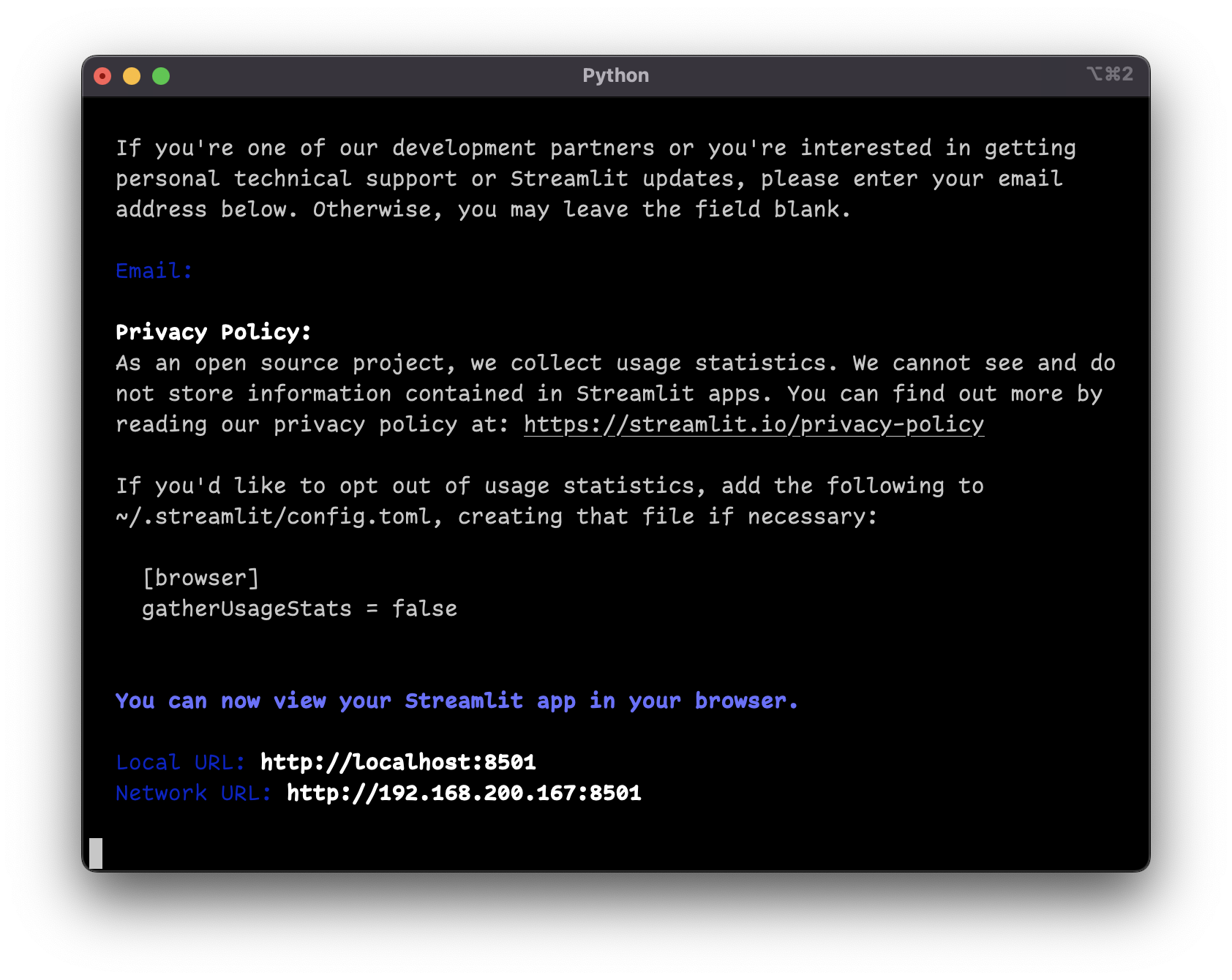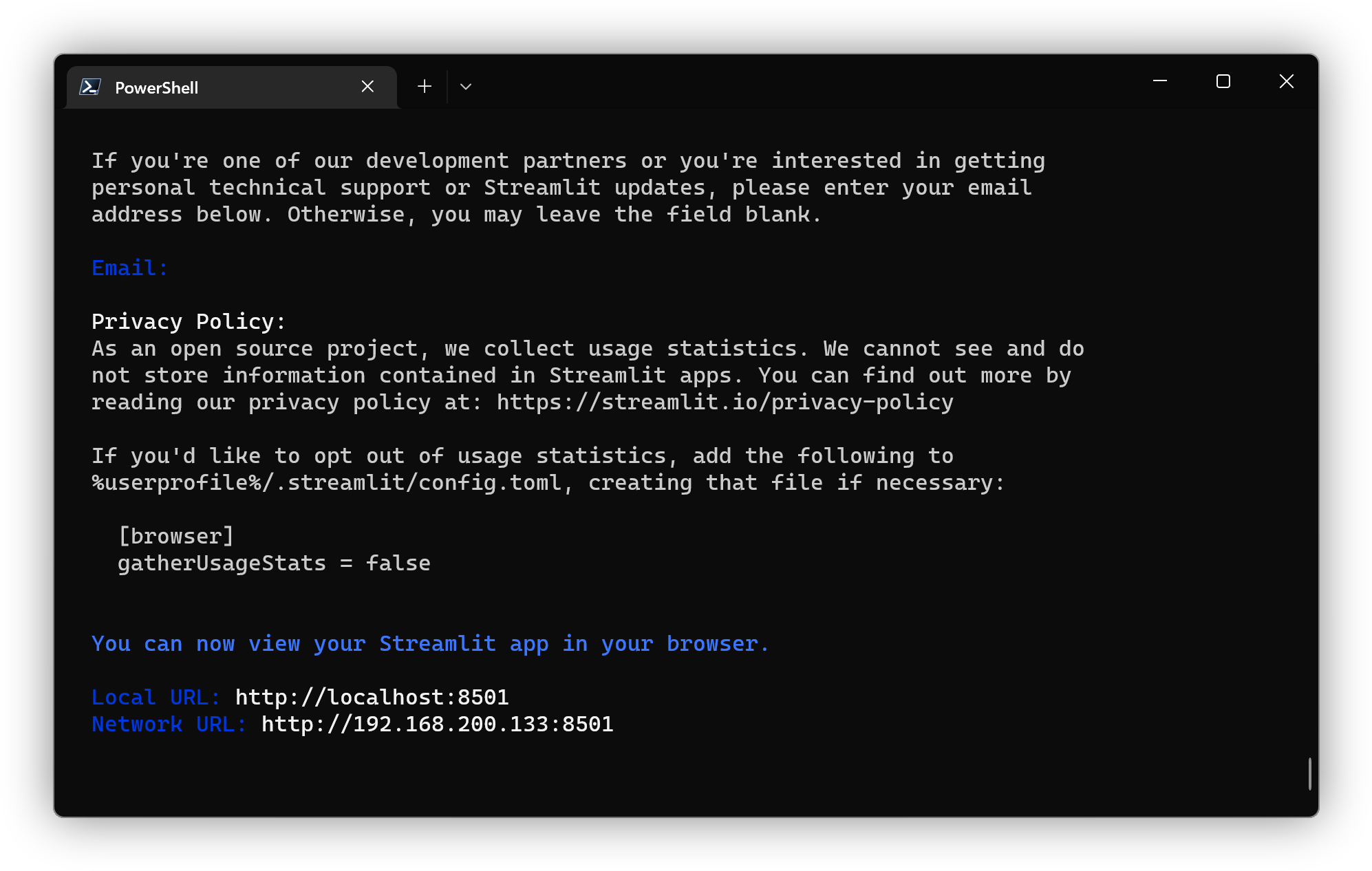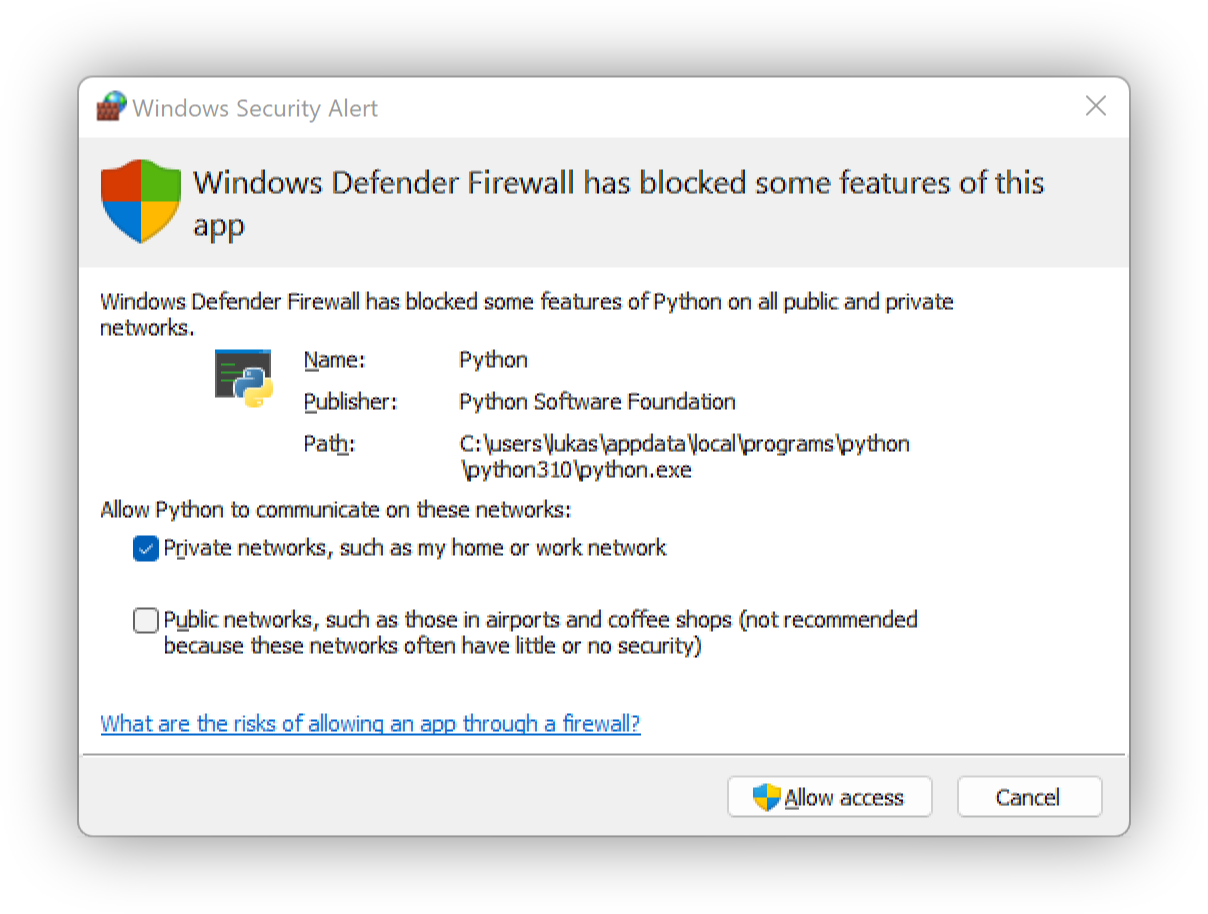Building a Web App with Streamlit
In Actionable Cloud Infrastructure Metrics, we explored how to create metrics, export them into a time series database, and visualize them with Grafana. Today, we'll take a look at how to build a web app using Streamlit, a framework that turns data into web apps.

If you are not familiar with Python, don't worry—we're going to keep it simple! In Prerequisites, we'll go over installing Python and the coding techniques utilized in this project.
If you're already comfortable with Python and just want the finished product, you can follow the steps in Environment Setup and jump straight to The Final Product. Then, see Running the App for instructions on how to start the app.
Many of the instructions below include commands to be executed in a terminal. The $, >, >>>, or ... at the beginning of each line indicates the prompt. You should not type or copy these characters.
When hovering over the upper right corner of a code block, you will see a copy button. You can use this to copy the commands within the code block to your clipboard without these prompts.
Prerequisites
- A text editor (I personally use Visual Studio Code)
- Python 3.8+
pip(the Python package installer)- Resoto 😉
If you already these prerequisites installed, you can skip ahead to Environment Setup.
Python and pip
- Linux
- macOS
- Windows
On Linux, there is a good chance the distro already comes with a version of Python 3.x installed. If you are not sure, you can check with the following command:
$ python3 --version
Python 3.10.4
If the command returns an error, you can install Python and pip using your distro's package manager:
- Debian/Ubuntu
- Fedora/CentOS
$ sudo apt update
$ sudo apt install python3 python3-pip
$ sudo dnf install python3 python3-pip
- Download
- Homebrew
You can download the latest version of Python for macOS from Python.org:
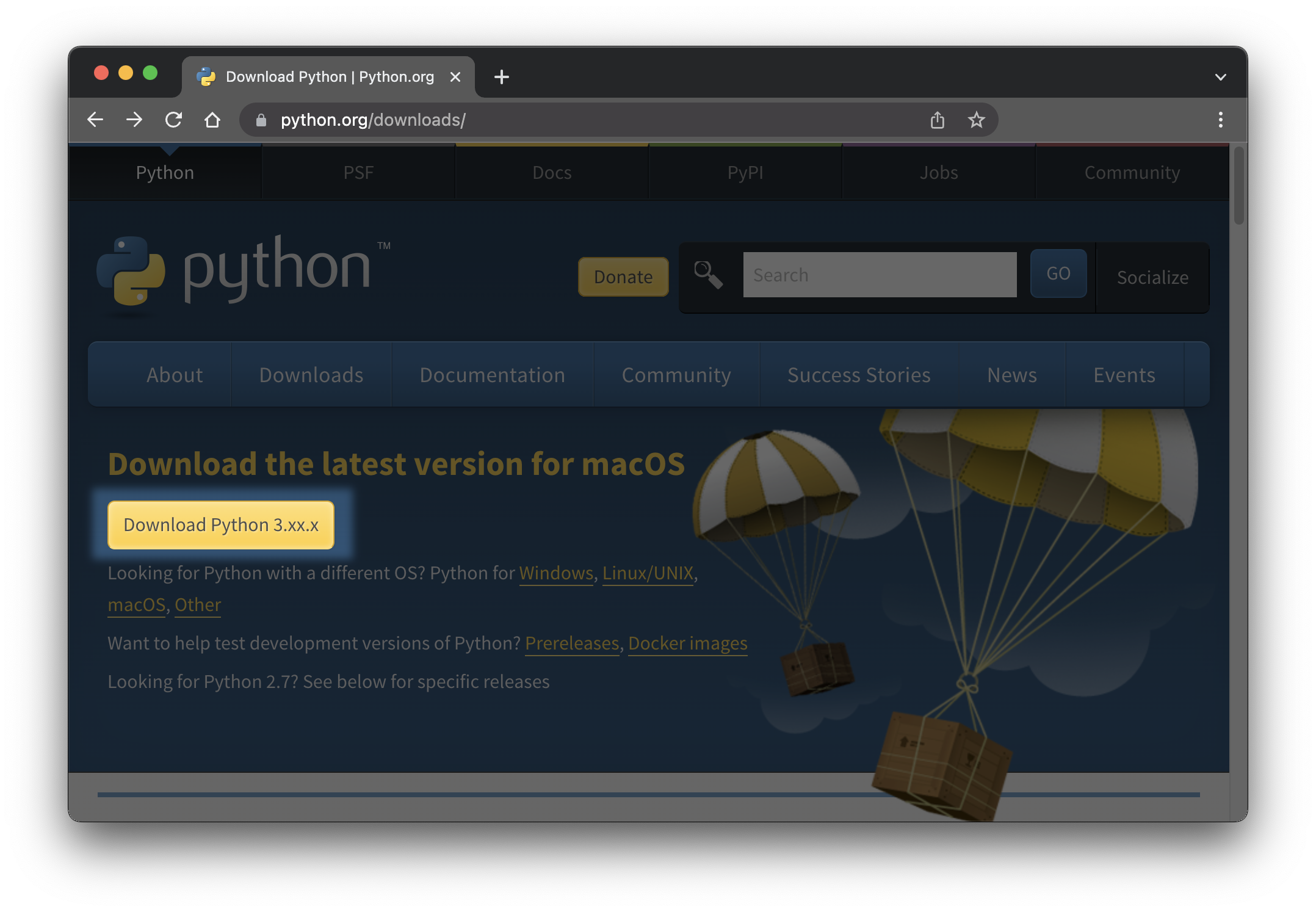
With Homebrew, you can install Python by executing the following command in the Terminal app:
$ brew install python
The Terminal app can be found under Utilities within the Applications folder:
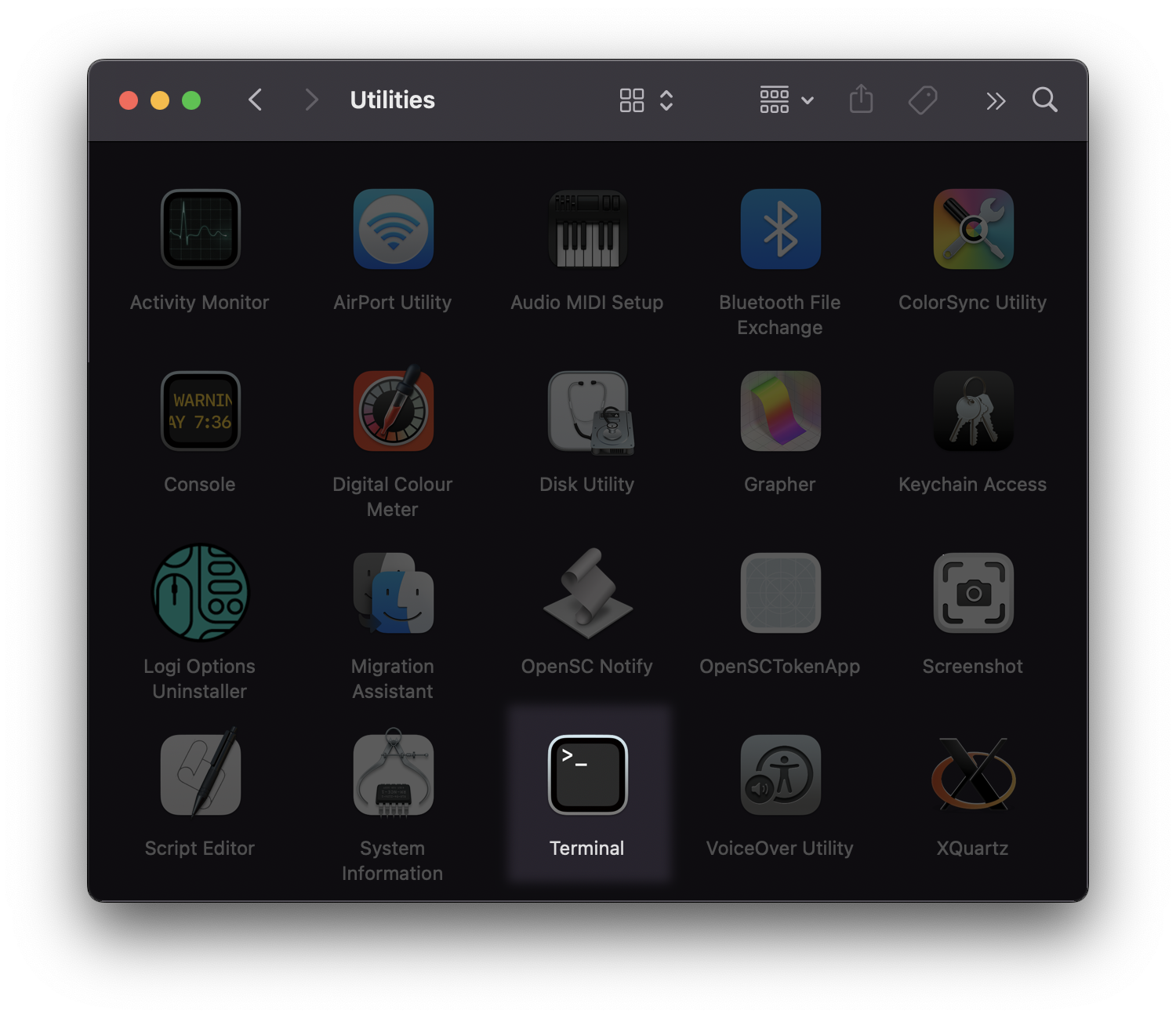
- Download
- Chocolatey
You can download the latest version of Python for Windows from Python.org:
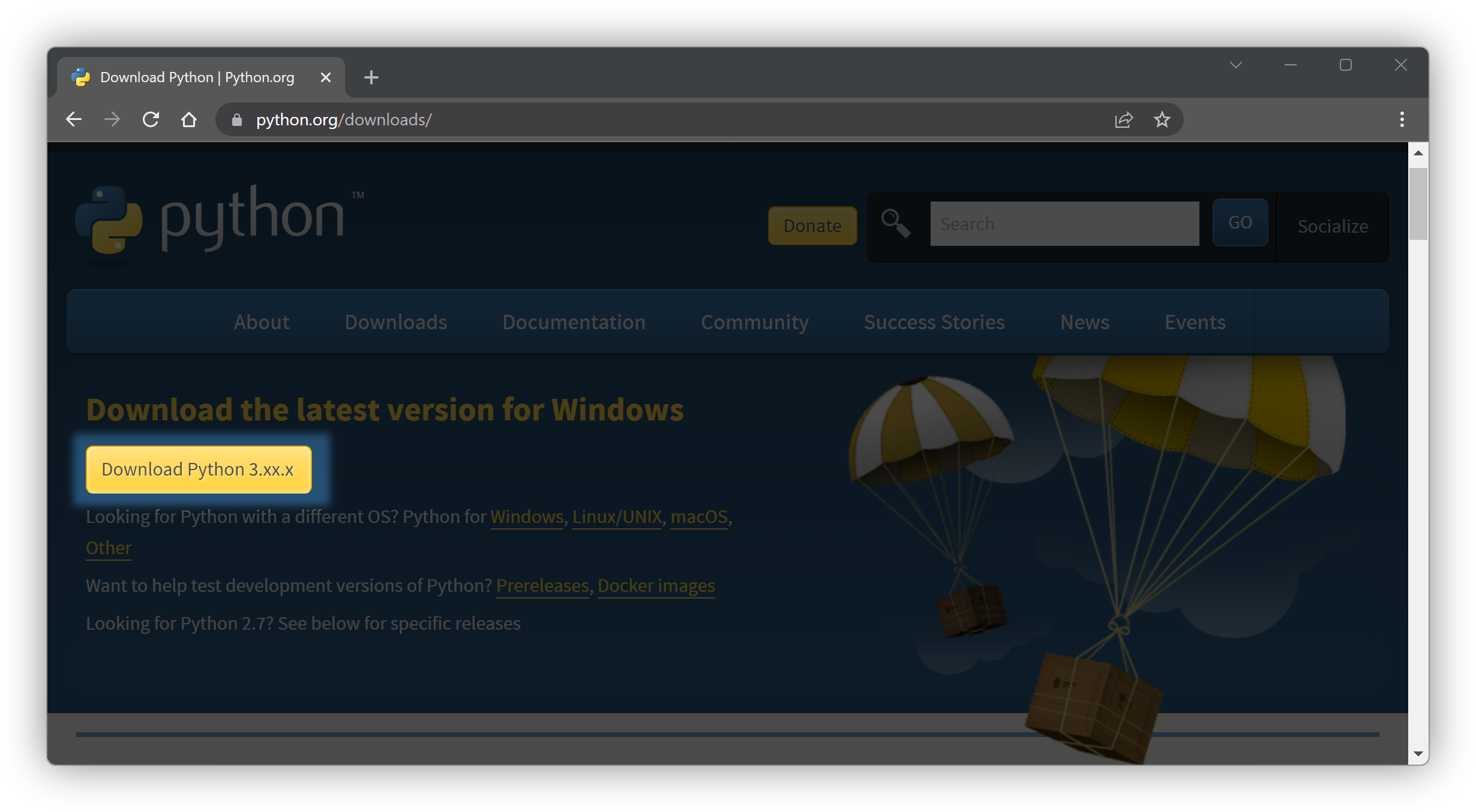
With Chocolatey, you can install Python by executing the following command:
choco install python
If you don't have prior Python or programming experience, please read the following overview of some Python basics before proceeding:
Python Basics
Starting the REPL
Start Python by running the following command (in PowerShell on Windows or the Terminal app on macOS):
$ python3
Python 3.10.4 (v3.10.4:9d38120e33, Mar 23 2022, 17:29:05) [Clang 13.0.0 (clang-1300.0.29.30)] on darwin
Type "help", "copyright", "credits" or "license" for more information.
>>>
Depending on how Python was installed, the command may be python instead of python3.
This starts the Python REPL. The REPL is a great way to quickly test code. You can type in a command, execute it by pressing the Enter key, and see the result printed to the screen.
To exit the REPL, simply type exit() and press Enter.
Variables and Functions
Variables store values. They are created by assigning a value to a name. The name can be any combination of letters, numbers, and underscores, but it must start with a letter or underscore.
Functions group code into a single unit. Functions can be called by using the function name followed by a list of arguments in parentheses. For this app we won't write any functions ourselves but we will call existing functions.
In the following code, we assign the value "Monday" to a variable named today and then use the print() function to output the value of the variable.
>>> today = "Monday"
>>> print(today)
Monday
Types of Variables
There are different types of variables. The most common are strings, integers, and floats. Strings are used to store text. Integers are used to store whole numbers. Floats are used to store decimal numbers. There are also booleans, which can be either True or False, and lists and dictionaries which are used to store multiple values. To access a value in a list we use an index, which is a number that starts at 0, 0 being the first element of a list. Dictionaries are similar to lists, but instead of using a number to access a value, you can use a string. Lists are created by using square brackets [] and dictionaries are created by using curly brackets {}.
Let's quickly go through some examples of each type of variable.
>>> greeting = "Hello there! 👋"
>>> number_of_colleagues = 7
>>> current_temperature = 74.6
>>> window_closed = True
>>> pancake_ingredients = ["flour", "eggs", "milk", "salt", "baking powder"]
>>> capital_cities = {
... "England": "London",
... "Germany": "Berlin",
... "USA": "Washington DC",
... "Lebanon": "Beirut",
... "Nepal": "Kathmandu",
... "Spain": "Madrid"
... }
>>> type(greeting)
<class 'str'>
>>> type(number_of_colleagues)
<class 'int'>
>>> type(current_temperature)
<class 'float'>
>>> type(window_closed)
<class 'bool'>
>>> type(pancake_ingredients)
<class 'list'>
>>> type(capital_cities)
<class 'dict'>
Accessing and Printing Variables
Let's look at some examples illustrating how to access and print variable values:
>>> print(current_temperature)
74.6
>>> print(f"The current temperature is {current_temperature}F")
The current temperature is 74.6F
>>> pancake_ingredients[0]
'flour'
>>> pancake_ingredients[3]
'salt'
>>> {capital_cities['USA']}
{'Washington DC'}
>>> print(f"The capital city of England is {capital_cities['England']}")
The capital city of England is London
>>> capital_cities.get("USA")
'Washington DC'
>>> capital_cities.get("USA", "Unknown")
'Washington DC'
>>> capital_cities.get("USAwoiuebcroiuw", "Unknown")
'Unknown'
Modifying Variables
Variables can be changed by assigning a new value:
>>> current_temperature = 75.2
>>> print(f"The current temperature is {current_temperature}F")
The current temperature is 75.2F
>>> current_temperature = current_temperature + 5
>>> print(f"The current temperature is {current_temperature}F")
The current temperature is 80.2F
>>> current_temperature += 10
>>> print(f"The current temperature is {current_temperature}F")
The current temperature is 90.2F
Multiple Assignment
Multiple variables can be assigned in a single line by comma-delimiting the variable names and values:
>>> name, age, city = "John", 36, "New York"
>>> print(f"My name is {name}, I am {age} years old, and I live in {city}.")
My name is John, I am 36 years old, and I live in New York.
Some functions also return multiple values. In such cases, the values can be assigned to multiple variables in the same fashion.
Conditionals
Sometimes, we want to take different actions depending on the value of a variable. We can define this logic using an if statement.
The following code will print a different message depending on the value of window_closed:
>>> if window_closed:
... print("The window is closed.")
... else:
... print("The window is open.")
The window is closed.
It is also possible to chain multiple if statements together using elif (short for "else if").
The following code will print a different message depending on the value of current_temperature:
>>> if current_temperature < 50:
... print("It's cold outside.")
... elif current_temperature < 70:
... print("It's warm outside.")
... else:
... print("It's hot outside.")
It's hot outside.
Multiple conditions can be checked using the and and or operators:
>>> if current_temperature < 50 and window_closed:
... print("It's cold and the window is closed.")
... elif current_temperature < 50 or window_closed:
... print("It's cold or the window is closed.")
... else:
... print("It's warm and the window is open.")
It's warm and the window is open.
Resoto
If you are new to Resoto, start the Resoto stack and configure it to collect your cloud accounts.
The App
So, what should the app look like? I am mostly interested in compute and storage, as they are the most expensive resources on my cloud bill.
The steps below will guide you through creating an app with the following features:
- Instance metrics: The current number of compute instances, CPU cores, and memory across all AWS and Google Cloud accounts.
- Volume metrics: The current number of storage volumes and their sizes, again across all AWS and Google Cloud accounts.
- World map: A visualization of where in the world instances are running. If anyone starts compute instances in a region we don't typically use, I can easily spot it on a map.
- Top accounts and regions by cost: A list of accounts currently spending the most money.
- Instance age distribution: The average age of compute instances per account. (It should be investigated if a development account has a lot of old instances, as they are typically short lived.)
- Storage sunburst chart: A visualization of the distribution of storage volumes by cloud and account, to see at a glance if a account suddenly has a lot more storage than usual.
- Instance type heatmap: A visualization of the distribution of instance types by account. This allows us to easily spot outliers (e.g., if an account suddenly has a lot of instances of a high-core count type).
If you are interested in different resource types or metrics, you can easily adapt the below code to suit your needs.
Environment Setup
We are going to use a Python virtual environment to keep the project isolated from the rest of the system. (This is not strictly necessary, but is good practice to keep your system clean and avoid conflicts with other projects.)
-
Create a new project directory to store source code and the virtual environment.
- Linux/macOS
- Windows
In the Terminal app, create a new directory for your project, create a new virtual environment and activate it by running the following commands:
$ mkdir ~/resoto-app # create a new directory named resoto-app inside the home directory
$ cd ~/resoto-app # change into the new directory
$ python3 -m venv venv # create a new virtual environment named venv
$ source venv/bin/activate # activate the virtual environmentnoteThe
$in front of the line must not be entered into the terminal. It just indicates that the following command is to be entered on a user shell without elevated permissions. You can use the code boxes copy button ⧉, to copy the commands to your clipboard.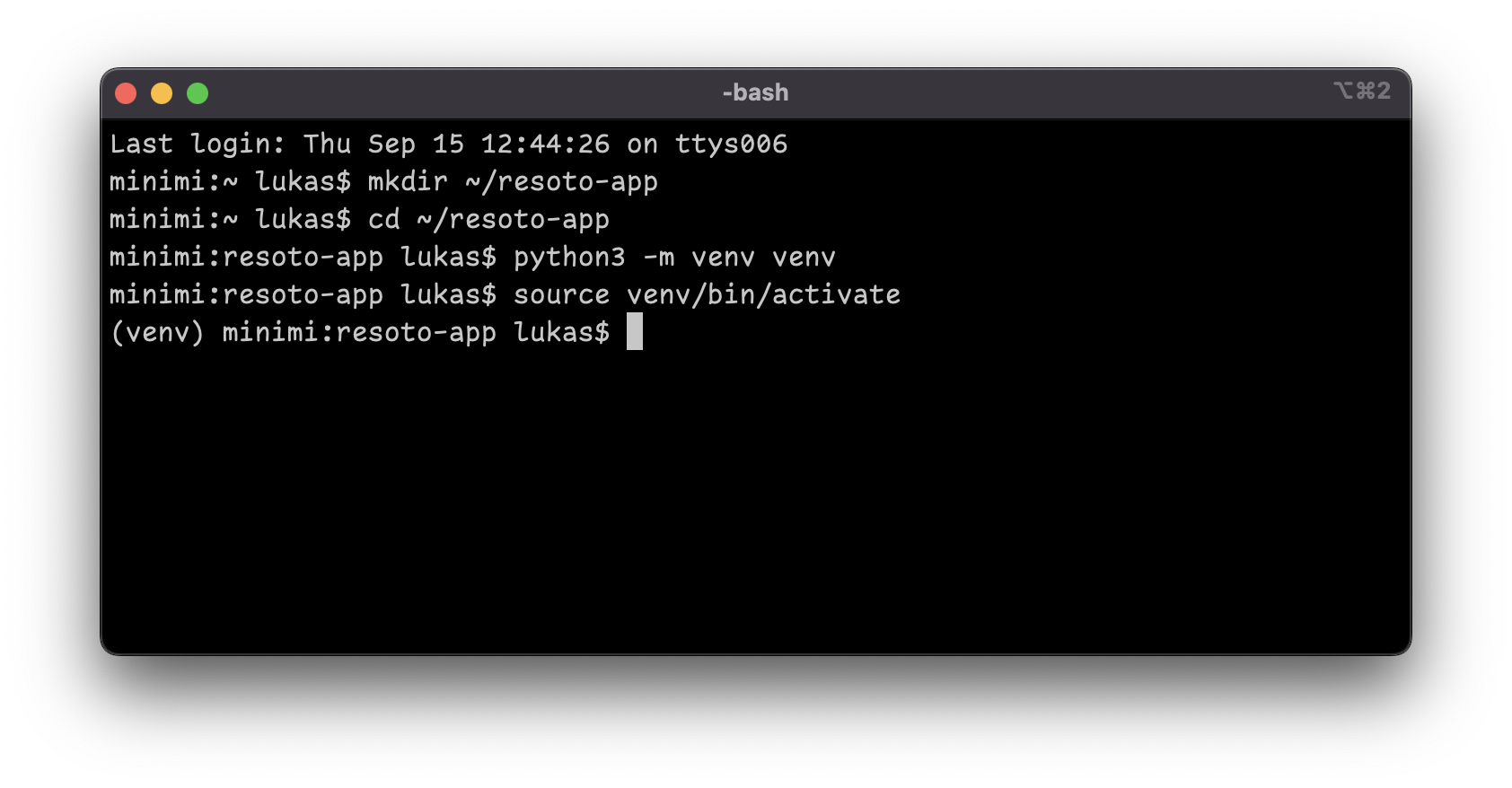 info
infoIf you close the Terminal app, you will need to re-activate the virtual environment the next time. Simply switch to the
resoto-appdirectory, then execute thevenv\Scripts\activatecommand:$ cd ~/resoto-app
$ source venv/bin/activateIn PowerShell, create a new directory for your project, create a new virtual environment and activate it by running the following commands:
> $documents = [Environment]::GetFolderPath("MyDocuments")
> md $documents\resoto-app
> cd $documents\resoto-app
> python -m venv venv
> venv\Scripts\activate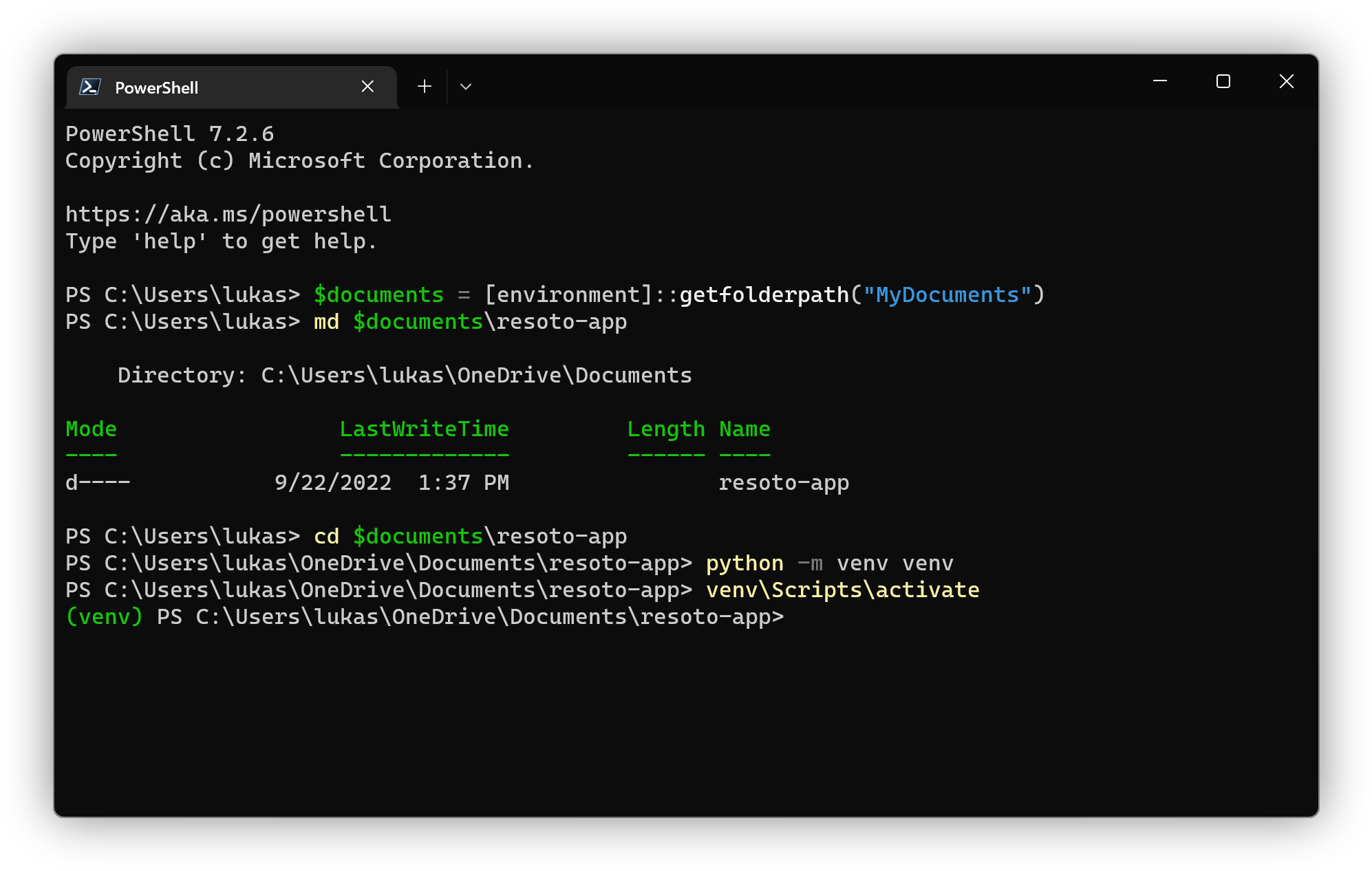 info
infoIf you close Powershell, you will need to re-activate the virtual environment the next time. Simply switch to the
resoto-appdirectory, then execute thevenv\Scripts\activatecommand:> cd $documents\resoto-app
> venv\Scripts\activate -
In your text editor, create a new file named
requirements.txtinside theresoto-appdirectory:requirements.txtresotoclient[extras]
resotodata
resotolib
streamlit
pydeck
numpywarningIn production environments, you should pin the version of each package (e.g.,
resotolib==2.4.1).Here's a quick overview of the dependencies:
Package Description streamlitThe framework we're using to create this web app. resotoclientThe Resoto Python client library, used to connect to the Resoto API to retrieve infrastructure data as Pandas dataframes and JSON resotodataContains static data, like the locations of cloud data centers. resotolibA collection of helper functions for Resoto. (The one we'll be using converts bytes into human-readable units like GiB, TiB, etc.) pydeckA library for making spatial visualizations. We'll use it to display the locations of cloud resources on a map. numpyA math library for working with the data Resoto returns. -
Now, we can install the dependencies listed in
requirements.txtusingpip:- Linux/macOS
- Windows
$ pip install -r requirements.txt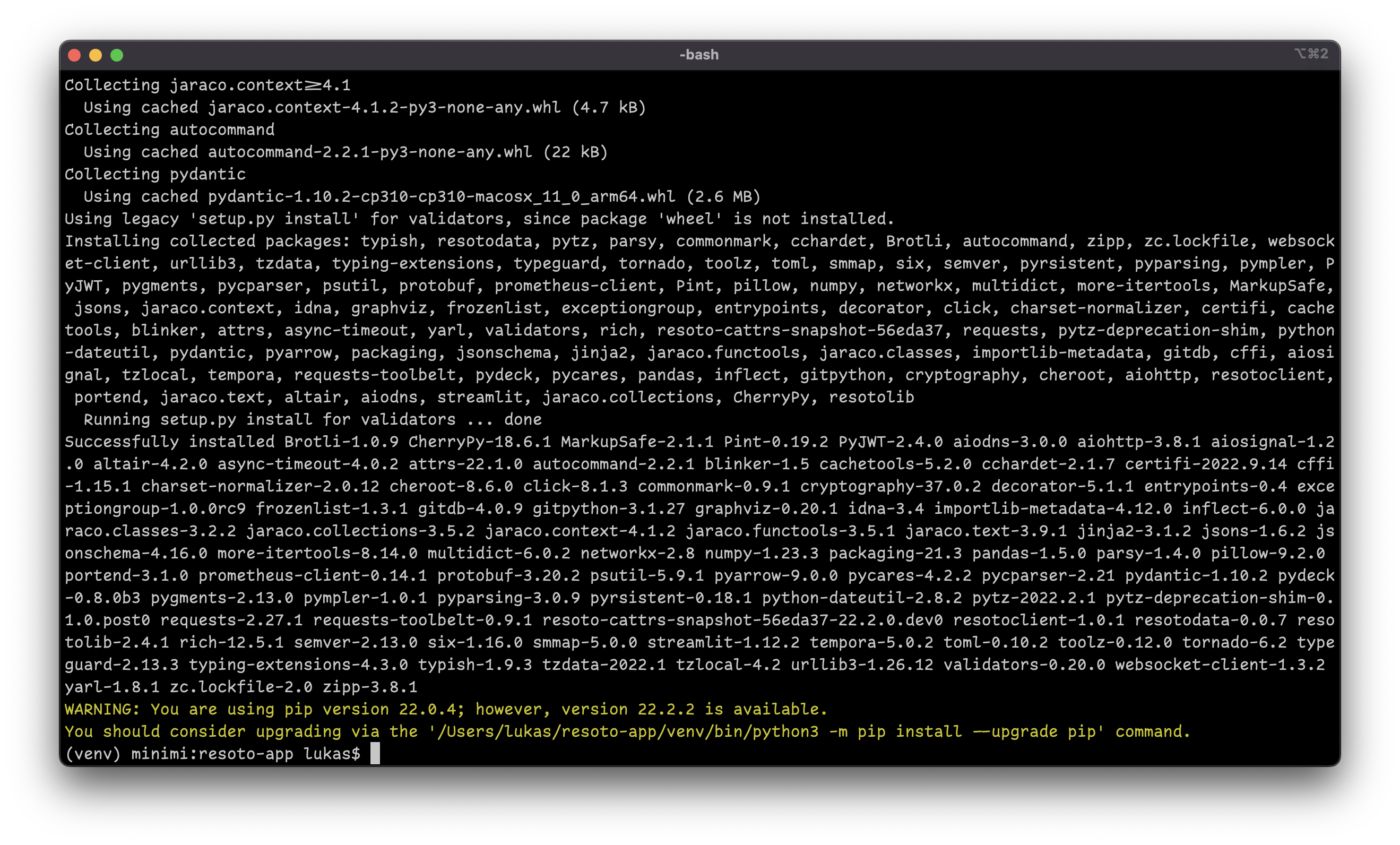
pip install -r requirements.txt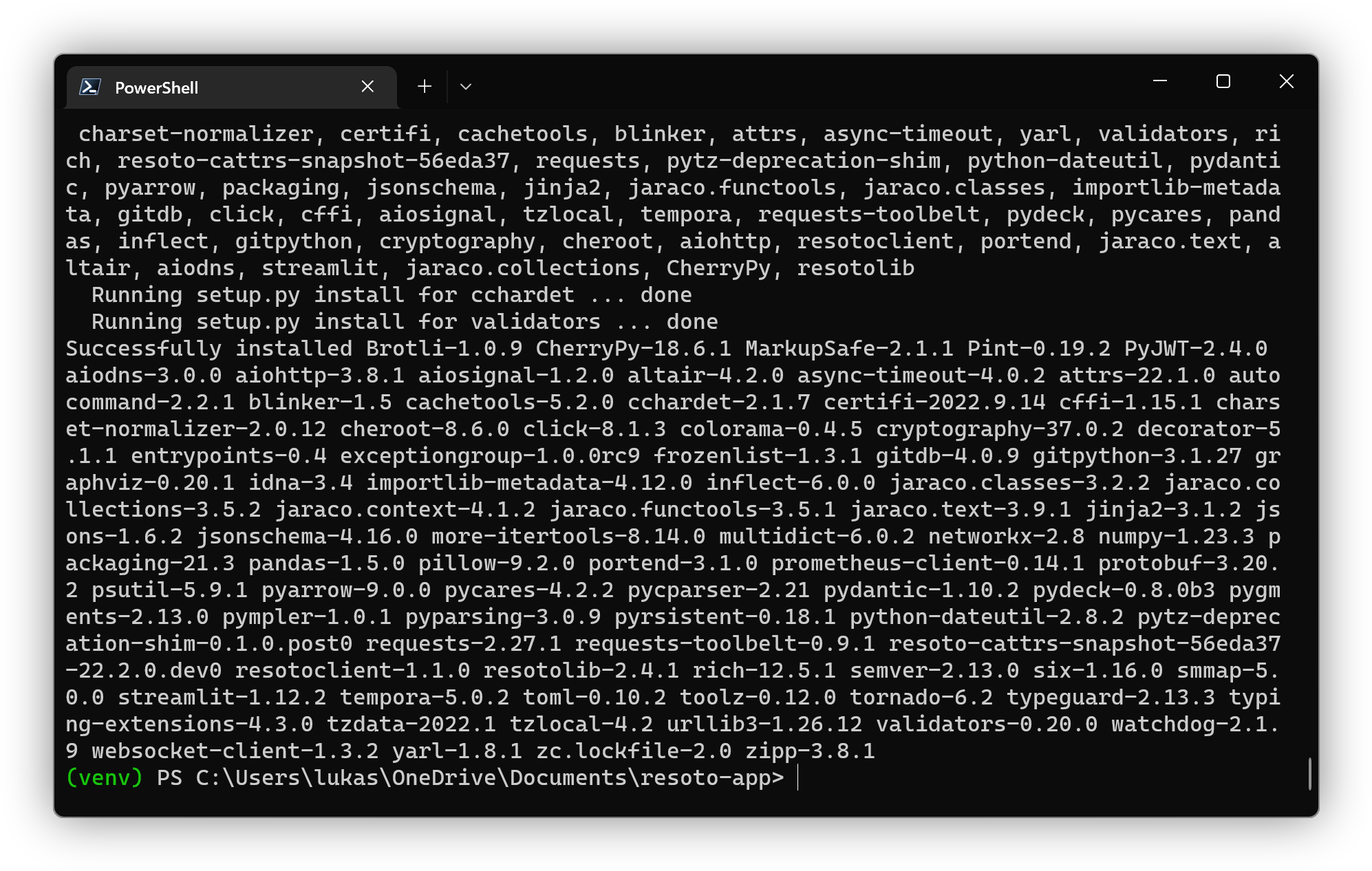 note
noteIf you encounter the
Microsoft Visual C++ 14.0 or greater is required.error message, download and install Microsoft C++ Build Tools as instructed.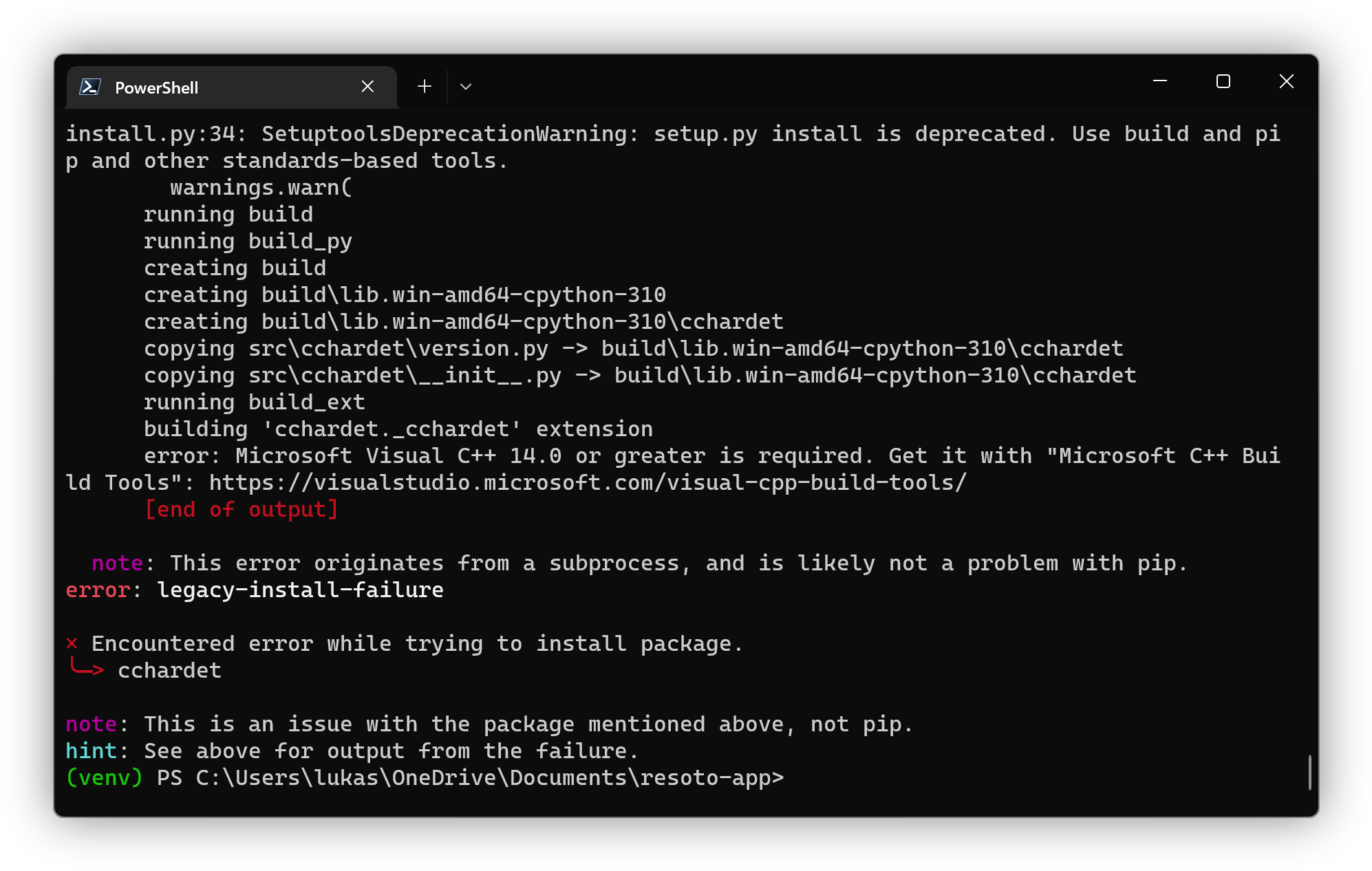
Be sure to select the Desktop development with C++ option during installation:
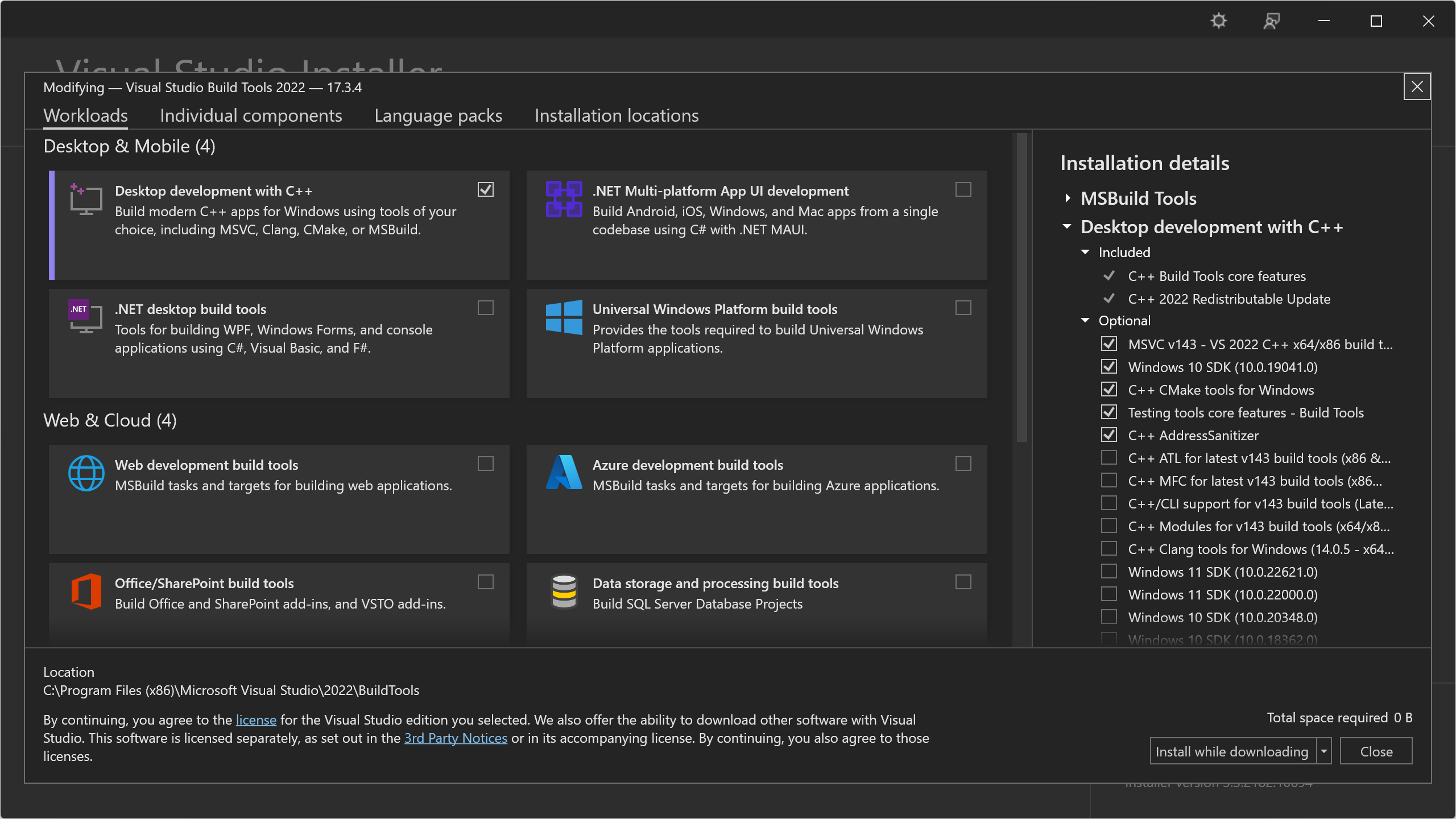
Once installation is complete, execute
pip install -r requirements.txtagain.
Creating a Demo App
Now that we've set up the project environment, we can start creating the infrastructure app.
Let's start with a simple demo app to verify that the environment is set up correctly.
-
Create a file
app.pyinside theresoto-appdirectory:app.pyimport streamlit as st
from resotoclient import ResotoClient
resoto = ResotoClient(url="https://localhost:8900", psk="changeme")
st.set_page_config(page_title="Cloud Dashboard", page_icon=":cloud:", layout="wide")
st.title("Cloud Dashboard")
df = resoto.dataframe("is(instance)")
st.dataframe(df)Code Explanation
Let's take a look at the meaning of each line of the above code.
import streamlit as st
from resotoclient import ResotoClientThis is the import section of the app. In it we import libraries that other people have written and made available to us. Imports typically happen at the beginning of a file. These two lines import the
streamlitandresotoclientlibraries into the project.- In the first import we use the
askeyword to assignstreamlita shorter name. - In the second line, instead of importing all of
resotoclientwe tell Python to only import theResotoClientclass.
resoto = ResotoClient(url="https://localhost:8900", psk="changeme")Here we initialize a new instance of the Resoto Client and assign it to the variable
resoto, passing a Resoto Core URL and pre-shared key (PSK) as arguments. The PSK is used to authenticate the client against the Resoto Core.st.set_page_config(page_title="Cloud Dashboard", page_icon=":cloud:", layout="wide")
st.title("Cloud Dashboard")These two lines set the page title and icon. The
page_iconargument is an emoji that will be displayed in the browser tab. Thelayoutargument tells Streamlit to use the full width of the browser window. Withst.titledf = resoto.dataframe("is(instance)")
st.dataframe(df)For now, these two lines are only here for demo purposes. We ask Resoto to search for everything that is a compute instance and return it as a Pandas DataFrame. We then pass the DataFrame to Streamlit's
st.dataframefunction to display it as a table in the app.Think of dataframes as an Excel spreadsheet. Resoto stores all of its data in a graph, and
resoto.dataframe()allows us to search that graph and flatten the result into a DataFrame that can be consumed by Streamlit. - In the first import we use the
-
Modify the
urlandpskvalues to match your local Resoto Core URL and pre-shared key. The above reflects the default values. -
Save the file and switch back to the terminal.
Running the App
-
Run Streamlit by executing following command:
-
Your browser should open
http://localhost:8501and display the following page: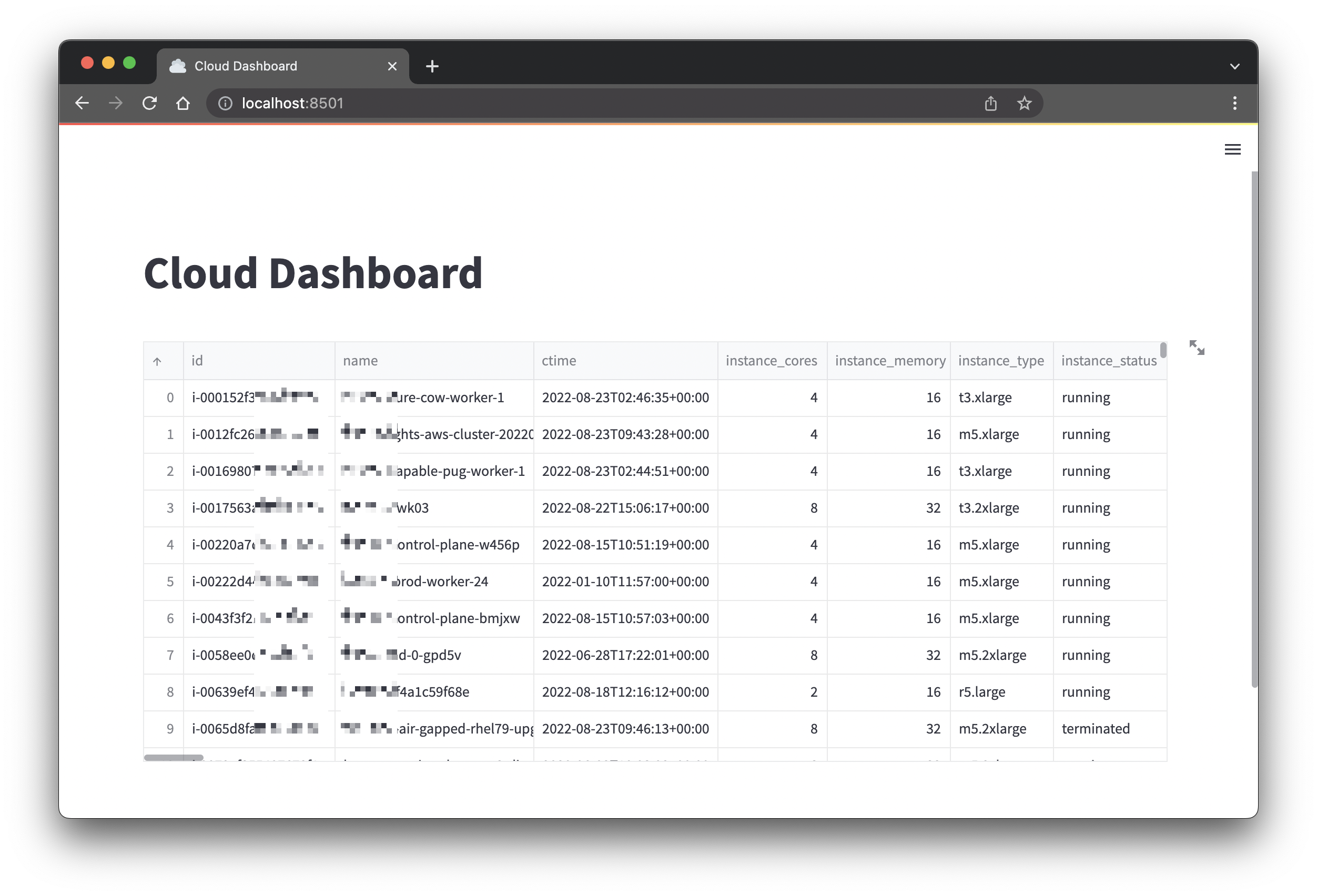
Defining the App Layout
Now that we have a basic app up and running, let's define the final desired layout.
-
Delete the last two lines of code from
app.py:- df = resoto.dataframe("is(instance)")
- st.dataframe(df) -
Then, add the following code:
col_instance_metrics, col_volume_metrics = st.columns(2)
col_instance_details, col_storage = st.columns(2)
map_tab, top10_tab, age_tab = col_instance_details.tabs(["Locations", "Top 10", "Age"])This gives us seven new variables:
col_instance_metricsandcol_volume_metricsare columns. Columns split the screen horizontally. Thest.columns()function takes a number as an argument and returns that many columns. We want two columns, so we pass the number2as the argument. These two columns are where we will add the instance and volume metrics.col_instance_detailsandcol_storageare also columns. The former is where we will add instance details and the latter is where we will add a sunburst chart.map_tab,top10_tabandage_tabare tabs. Tabs provide a way to switch between different views. Thest.tabs()function takes a list of tab names as an argument.
-
When you reload the app in your browser, it should now look like this:
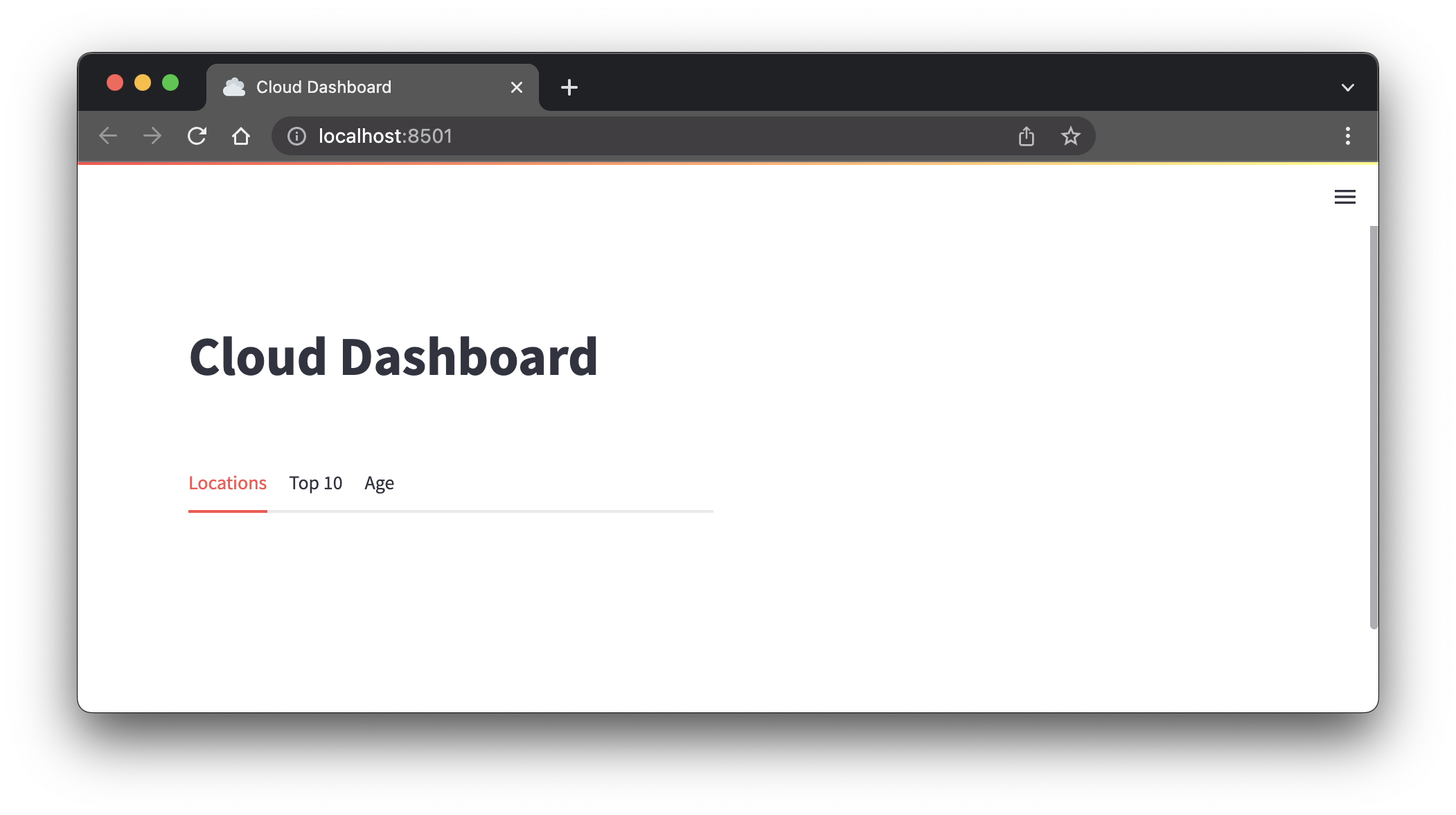
Adding Data
Now that the layout is in place, let's add some data!
Instance Metrics
We'll begin with instance metrics.
-
Add the following import at the top of
app.py:from resotolib.utils import iec_size_formatThis line imports a function
iec_size_format()that we will use to format the instance metrics. It turns bytes into human readable GiB, TiB, etc. -
Append the following code to the end of
app.py:resoto_search = "aggregate(sum(1) as instances_total, sum(instance_cores) as cores_total, sum(instance_memory*1024*1024*1024) as memory_total): is(instance)"
instances_info = list(resoto.search_aggregate(resoto_search))[0]
col_instance_metrics.metric("Instances", instances_info["instances_total"])
col_instance_metrics.metric("Cores", instances_info["cores_total"])
col_instance_metrics.metric("Memory", iec_size_format(instances_info["memory_total"]))Code Explanation
-
In the first line, we define a variable
resoto_searchwhich contains an aggregate search. You can copy and paste the search into Resoto Shell to see what it does.In short, it searches for all instances (
is(instance)) and returns the total number of instances (sum(1) as instances_total), the total number of CPU cores (sum(instance_cores) as cores_total) and the total amount of memory (sum(instance_memory*1024*1024*1024) as memory_total). (Instance memory is stored in GB in Resoto, but we need it in bytes so we multiply it by 1024*1024*1024 for the number of bytes.) -
In the second line, we execute the search and store the result in the variable
instances_info.The
list()function is used to convert the result into a list. The result is a generator, so we convert it into a list so we can access it by index. Since the aggregate search only returns a single result, we can access it at index0.The resulting content of
instances_infolooks like this:{
"cores_total": 3158,
"instances_total": 536,
"memory_total": 13202410860544
}When we use the
iec_size_format()function on thememory_totalvalue, we get a human readable string:>>> iec_size_format(instances_info["memory_total"])
'12.01 TiB' -
The final three lines of code use the
st.metric()function to display the instance metrics. Thest.metric()function takes three arguments: a label, a value and an optional delta. The delta is the difference between the current value and the previous value. We don't have a previous value so we don't use it.Because we don't want the metrics to be appended at the end of the page we apply the
metric()function on thecol_instance_metricsvariable we created earlier. This tells Streamlit to display the metrics in the appropriate column.
-
-
Reload the browser tab. You should see the instance metrics on the left side:
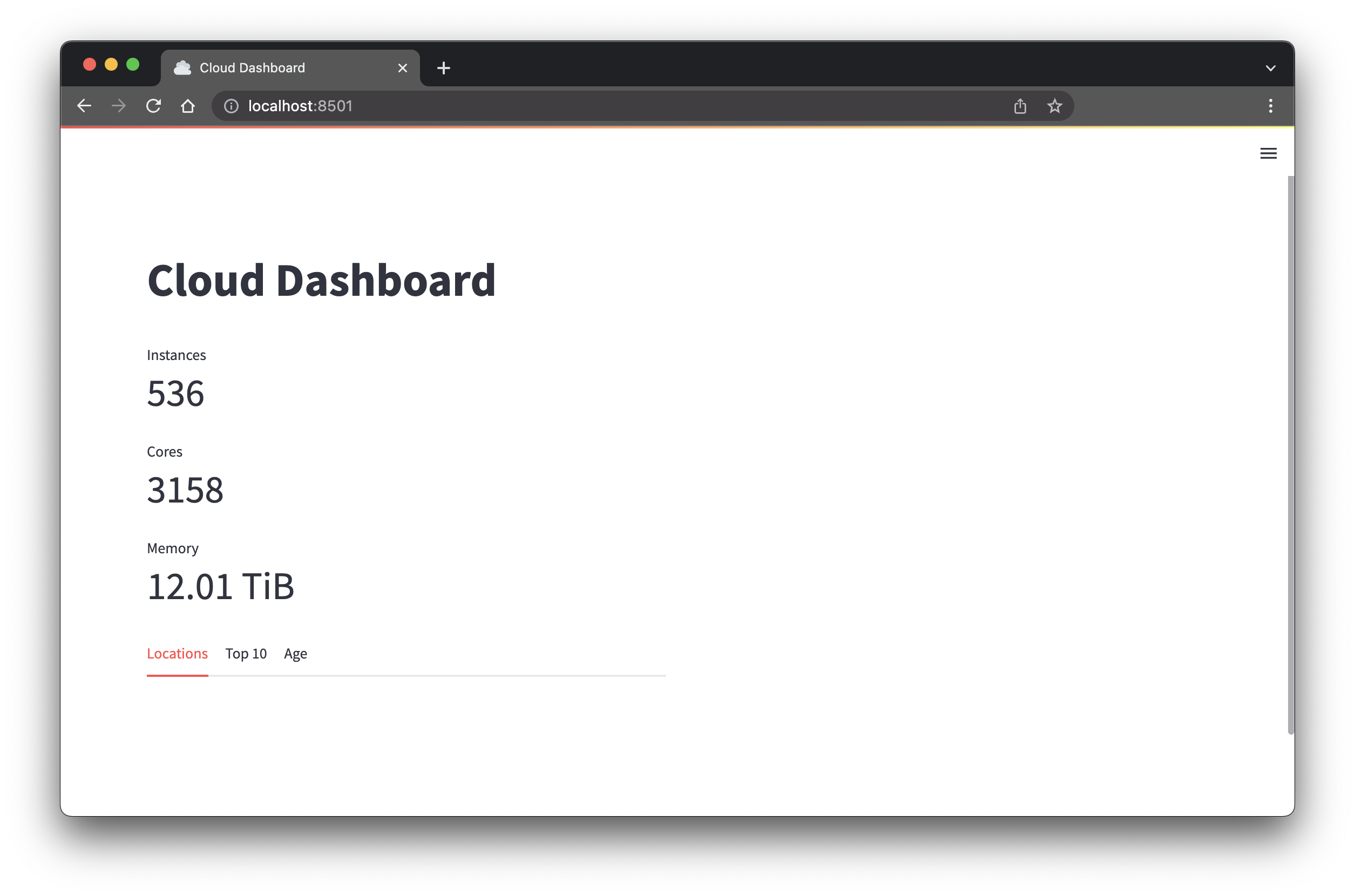
Volume Metrics
-
Append the following code to the end of
app.py:resoto_search = "aggregate(sum(1) as volumes_total, sum(volume_size*1024*1024*1024) as volumes_size): is(volume)"
volumes_info = list(resoto.search_aggregate(resoto_search))[0]
col_volume_metrics.metric("Volumes", volumes_info["volumes_total"])
col_volume_metrics.metric("Size", iec_size_format(volumes_info["volumes_size"]))The code is the same as for the instance metrics except that we search for volumes instead of instances.
-
Reload the browser tab. You should see volume metrics on the right side:
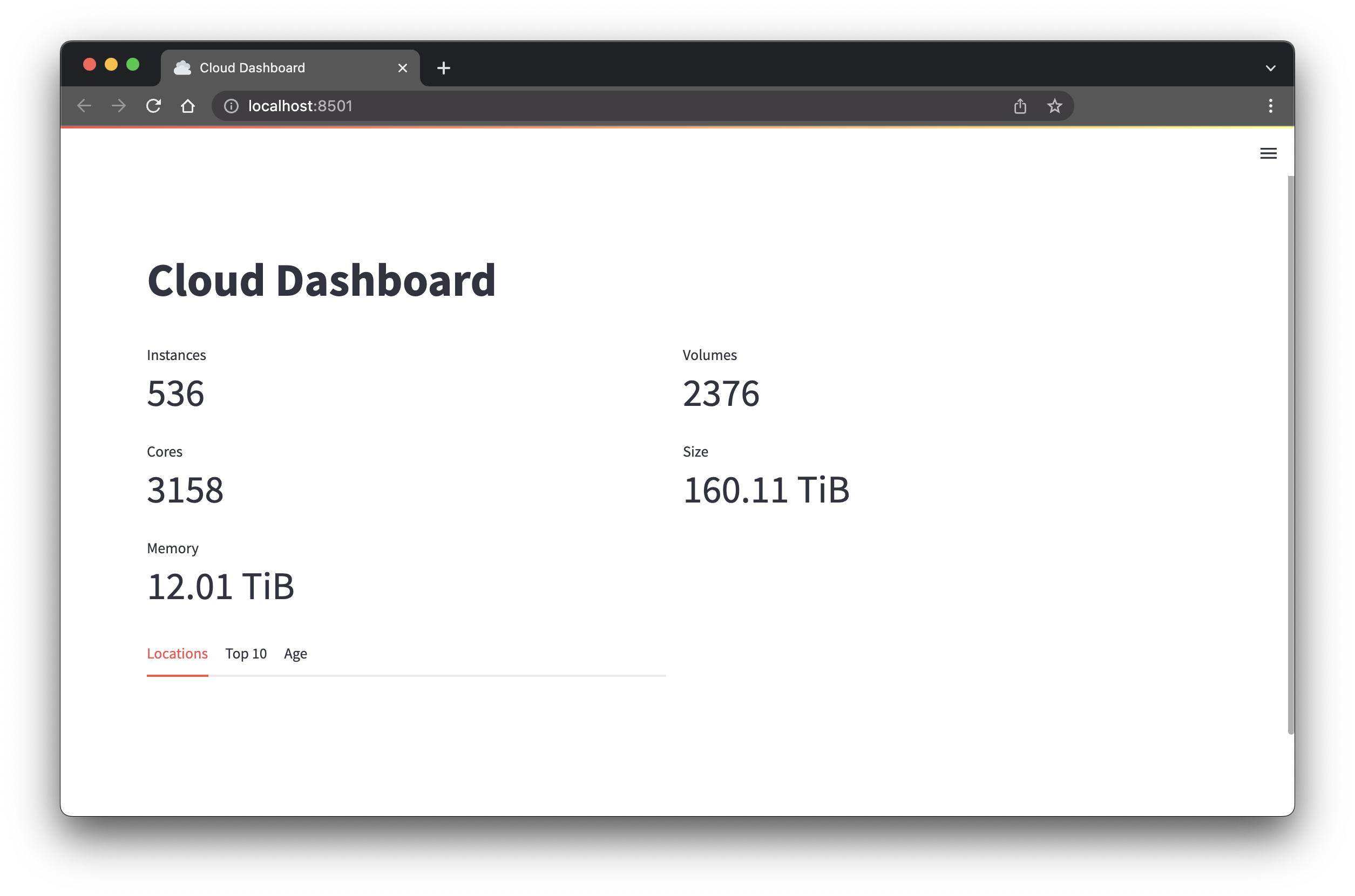
World Map
Next, we are going to add the most complex element of the app: a world map.
-
Add the following imports at the top of
app.py:import pydeck as pdk
import numpy as np
from resotodata.cloud import regions as cloud_regions -
Append the following code to the end of
app.py:resoto_search = "aggregate(/ancestors.cloud.reported.name as cloud, /ancestors.region.reported.name as region: sum(1) as instances_total): is(aws_ec2_instance) or is(gcp_instance)"
df = resoto.dataframe(resoto_search)
df["latitude"], df["longitude"] = 0, 0
for x, y in df.iterrows():
location = cloud_regions.get(y["cloud"], {}).get(y["region"], {})
df.at[x, "latitude"] = location.get("latitude", 0)
df.at[x, "longitude"] = location.get("longitude", 0)
midpoint = (np.average(df["latitude"]), np.average(df["longitude"]))
map_tab.pydeck_chart(
pdk.Deck(
map_style=None,
initial_view_state=pdk.ViewState(
latitude=midpoint[0], longitude=midpoint[1], zoom=2, pitch=50
),
tooltip={
"html": "<b>{instances_total}</b> instances running in {region} ({cloud})",
"style": {
"background": "grey",
"color": "white",
"font-family": '"Helvetica Neue", Arial',
"z-index": "10000",
},
},
layers=[
pdk.Layer(
"ColumnLayer",
data=df,
get_position=["longitude", "latitude"],
get_elevation="instances_total",
get_fill_color="cloud == 'aws' ? [217, 184, 255, 150] : [255, 231, 151, 150]",
elevation_scale=10000,
radius=100000,
pickable=True,
auto_highlight=True,
)
],
)
)Code Explanation
-
First, the three imports:
pydeckis used to create the world map.numpyis used to calculate the midpoint of the map.resotodata.cloudis used to get the latitude and longitude of the cloud provider regions.
-
We then do an aggregate search to get the number of instances per region. The search is similar to the one we used for the instance metrics. The only difference is that we also return the cloud provider and region name. We store the result in the variable
df, which is a PandasDataFrame. Theresoto.dataframe()function is used to convert the result into aDataFrame.The contents of the
DataFramelook something like this:>>> df
instances_total cloud region
0 7 aws eu-central-1
1 55 aws us-east-1
2 2 aws us-east-2
3 405 aws us-west-2
4 12 gcp us-central1 -
Next, we add two new columns to the DataFrame:
latitudeandlongitude. We use theresotodatalibrary to get the latitude and longitude of the cloud provider regions. We store the result in thelatitudeandlongitudecolumns.When we look at the structure of
cloud_regions, we see that it is a dictionary with the cloud provider names as keys. The value of each entry is another dictionary with region names as keys. The value of this region dictionary is an object containinglatitudeandlongitudeproperties:>>> print(cloud_regions)
{'aws': {'af-south-1': {'latitude': -33.928992,
'long_name': 'Africa (Cape Town)',
'longitude': 18.417396,
'short_name': 'af-south-1'},
'ap-east-1': {'latitude': 22.2793278,
'long_name': 'Asia Pacific (Hong Kong)',
'longitude': 114.1628131,
'short_name': 'ap-east-1'},
... -
The
midpointvariable is used to center the map. We use thenumpylibrary to calculate the average latitude and longitude of the DataFrame. -
We then use the
pydecklibrary to create the map. Thepydecklibrary is used to create interactive maps in Python.We use
ColumnLayerto create the map.ColumnLayeris used to create 3-D columns. We use thelatitudeandlongitudecolumns to position the columns and theinstances_totalcolumn to set the height.The tertiary operator (
?) is used to set the color based on the value of thecloudcolumn:get_fill_color="cloud == 'aws' ? [217, 184, 255, 150] : [255, 231, 151, 150]",This has the same result as the following code:
if cloud == 'aws':
get_fill_color = [217, 184, 255, 150]
else:
get_fill_color = [255, 231, 151, 150]The four elements of the
get_fill_colorlist are the red, green, blue, and alpha values. The alpha value defines the transparency of the color.See the
pydeckdocumentation for more information aboutColumnLayer.
-
-
Reload the browser tab. You should see a world map displaying where your instances are running:
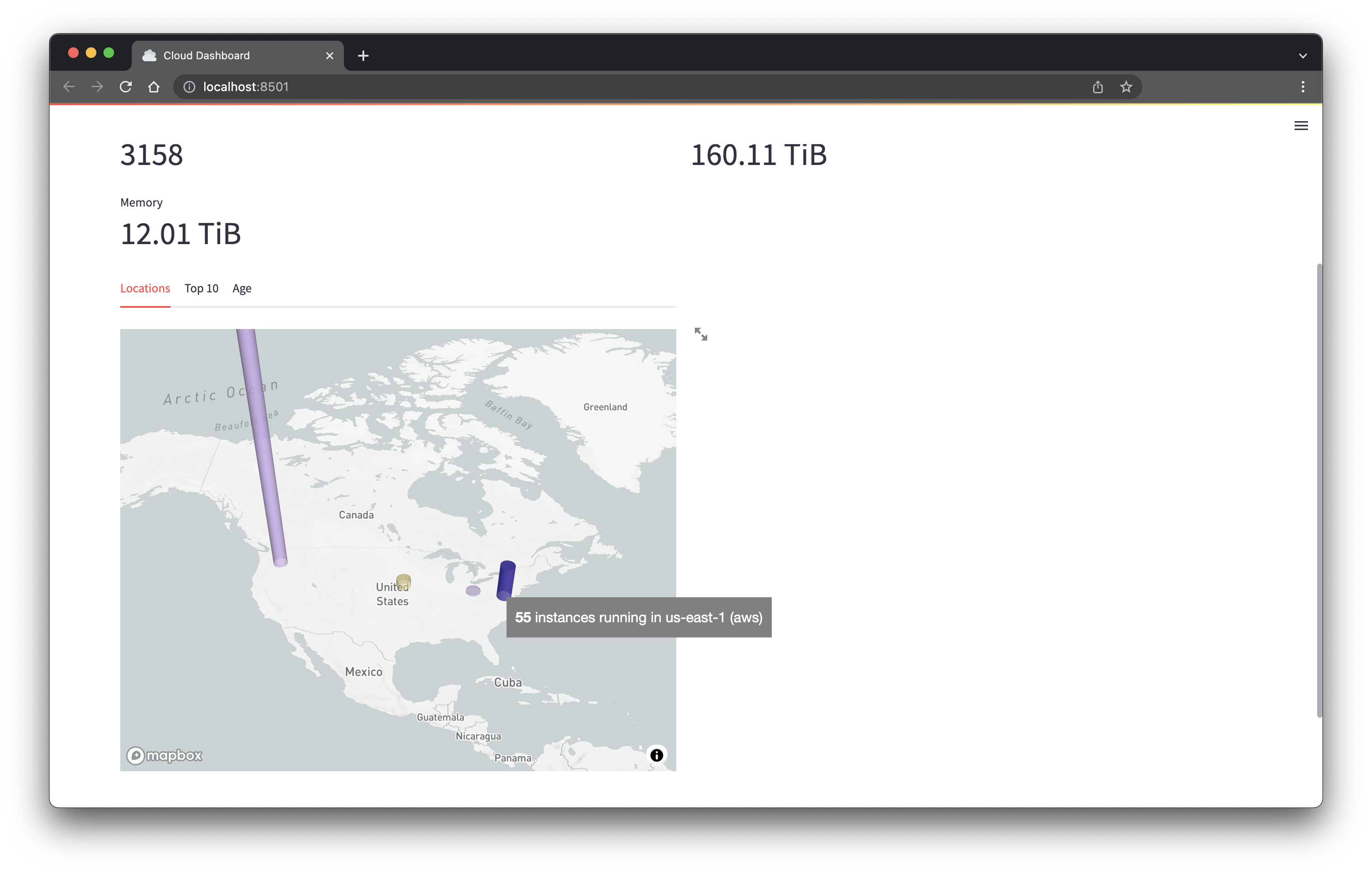
Top 10
This is an easy one. It's similar to the demo app, but instead of displaying the dataframe unchanged we use some of Panda's built-in functions to display the top 10 accounts and regions by on-demand cost.
-
Append the following code to the end of
app.py:top10_tab.header("Top 10 accounts and regions")
resoto_search = "aggregate(/ancestors.cloud.reported.name as cloud, /ancestors.account.reported.name as account, /ancestors.region.reported.id as region: sum(/ancestors.instance_type.reported.ondemand_cost) as ondemand_cost): is(instance)"
df = (
resoto.dataframe(resoto_search)
.nlargest(n=10, columns=["ondemand_cost"])
.sort_values(by=["ondemand_cost"], ascending=False)
.reset_index(drop=True)
)
top10_tab.table(df.style.format({"ondemand_cost": "${:.2f}/h"}))Code Explanation
The DataFrame looks like this:
>>> resoto.dataframe(resoto_search)
ondemand_cost cloud account region
0 0.166400 aws eng-devprod us-east-1
1 0.768000 aws eng-devprod us-west-2
2 7.104000 aws eng-sphere-insights us-west-2
3 0.192000 aws eng-sphere-platform us-east-1
4 26.304000 aws eng-sphere-platform us-west-2
5 3.648000 aws eng-ksphere-soak us-east-1
6 6.460800 aws eng-ksphere-soak us-west-2
7 0.166400 aws eng-qualification us-east-1
...We then sort the DataFrame by the
ondemand_costcolumn and only show the top 10 rows. We use thetop10_tab.table()function to display the DataFrame as a table.The
style.format()function formats theondemand_costcolumn with a Python format string.:.2fmeans that we want a floating-point number with two decimal places. -
Reload the browser, select the "Top 10" tab and you should see the following:
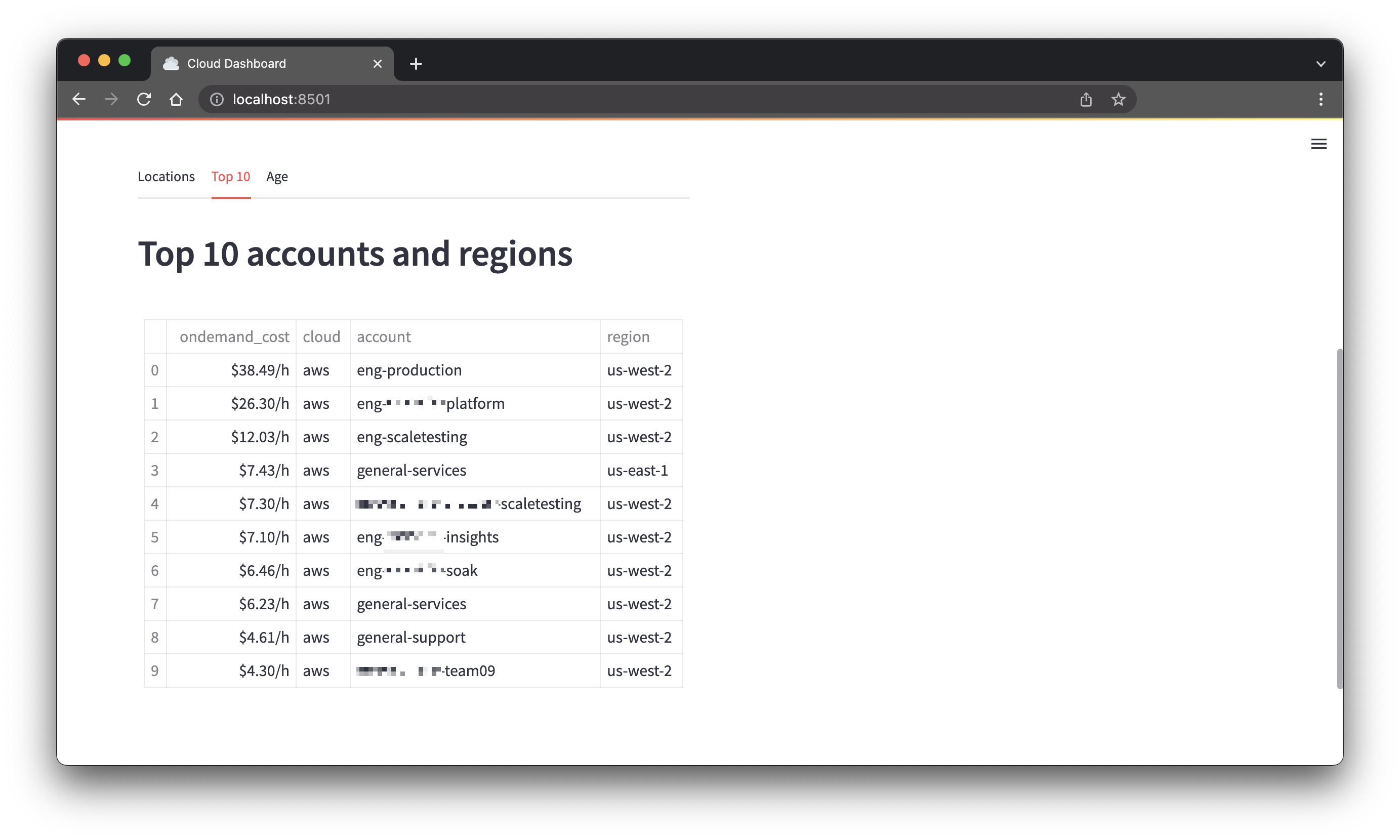
Sunburst Chart
-
Add the following import at the top of
app.py:import plotly.express as pxWe use the
plotly.expresslibrary to create the sunburst chart. Theplotlylibrary is used to create interactive charts in Python. -
Append the following code to the end of
app.py:resoto_search = "aggregate(/ancestors.cloud.reported.name as cloud, /ancestors.account.reported.name as account: sum(volume_size*1024*1024*1024) as volume_size): is(volume)"
df = resoto.dataframe(resoto_search)
df["volume_size_human"] = df["volume_size"].apply(iec_size_format)
fig = px.sunburst(
df,
path=["cloud", "account"],
values="volume_size",
hover_data=["cloud", "account", "volume_size_human"],
)
fig.update_traces(hoverinfo="label+percent entry", textinfo="label+percent entry")
col_storage.plotly_chart(fig)Code Explanation
This aggregate search returns a DataFrame that looks like this:
>>> resoto.dataframe(resoto_search)
volume_size cloud account
0 223338299392 aws eng-devprod
1 2940978855936 aws eng-sphere-insights
2 2147483648 aws eng-sphere-kudo
3 11857330962432 aws eng-sphere-platform
4 5625333415936 aws eng-sphere-soak
5 4778151116800 aws eng-ds
...-
df["volume_size_human"] = df["volume_size"].apply(iec_size_format)adds a new column to the DataFrame. The new column is calledvolume_size_humanand it contains the volume size in human readable format by asking Pandas to apply theiec_size_formatfunction to thevolume_sizecolumn. -
px.sunburst()creates a sunburst chart from the DataFrame. Thepathargument tells the function which columns to use for the different levels of the sunburst chart. Thevaluesargument tells the function which column to use for the size of the slices. Thehover_dataargument tells the function which columns to show when hovering over a slice. -
fig.update_traces()updates the properties of the slices. Thehoverinfoargument tells the function which information to show when hovering over a slice. Thetextinfoargument tells the function which information to show in the center of the sunburst chart.
-
-
Reload the browser and you should see a sunburst chart:
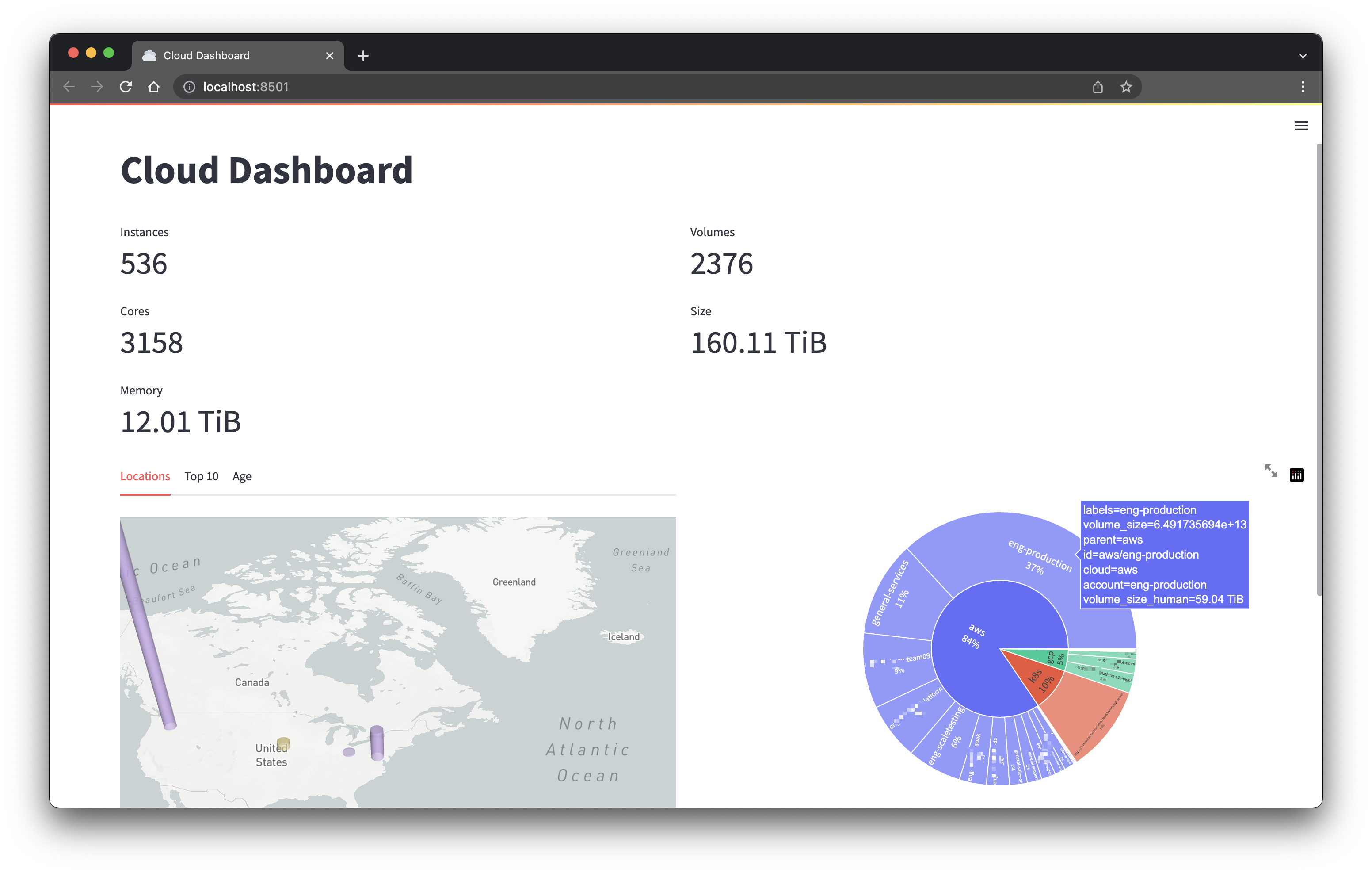
Heatmap
This will be quite similar to the sunburst chart; we're again using the plotly.express library.
-
Append the following code to the end of
app.py:st.header("Instance Types")
resoto_search = "aggregate(/ancestors.cloud.reported.name as cloud, /ancestors.account.reported.name as account_name, instance_type as instance_type, instance_cores as instance_cores: sum(1) as instances): is(instance)"
df = resoto.dataframe(resoto_search).sort_values(by=["instance_cores"])
fig = px.density_heatmap(
df,
x="instance_type",
y="account_name",
z="instances",
color_continuous_scale="purples",
)
st.plotly_chart(fig, use_container_width=True) -
Reload the browser and you should see a heatmap:
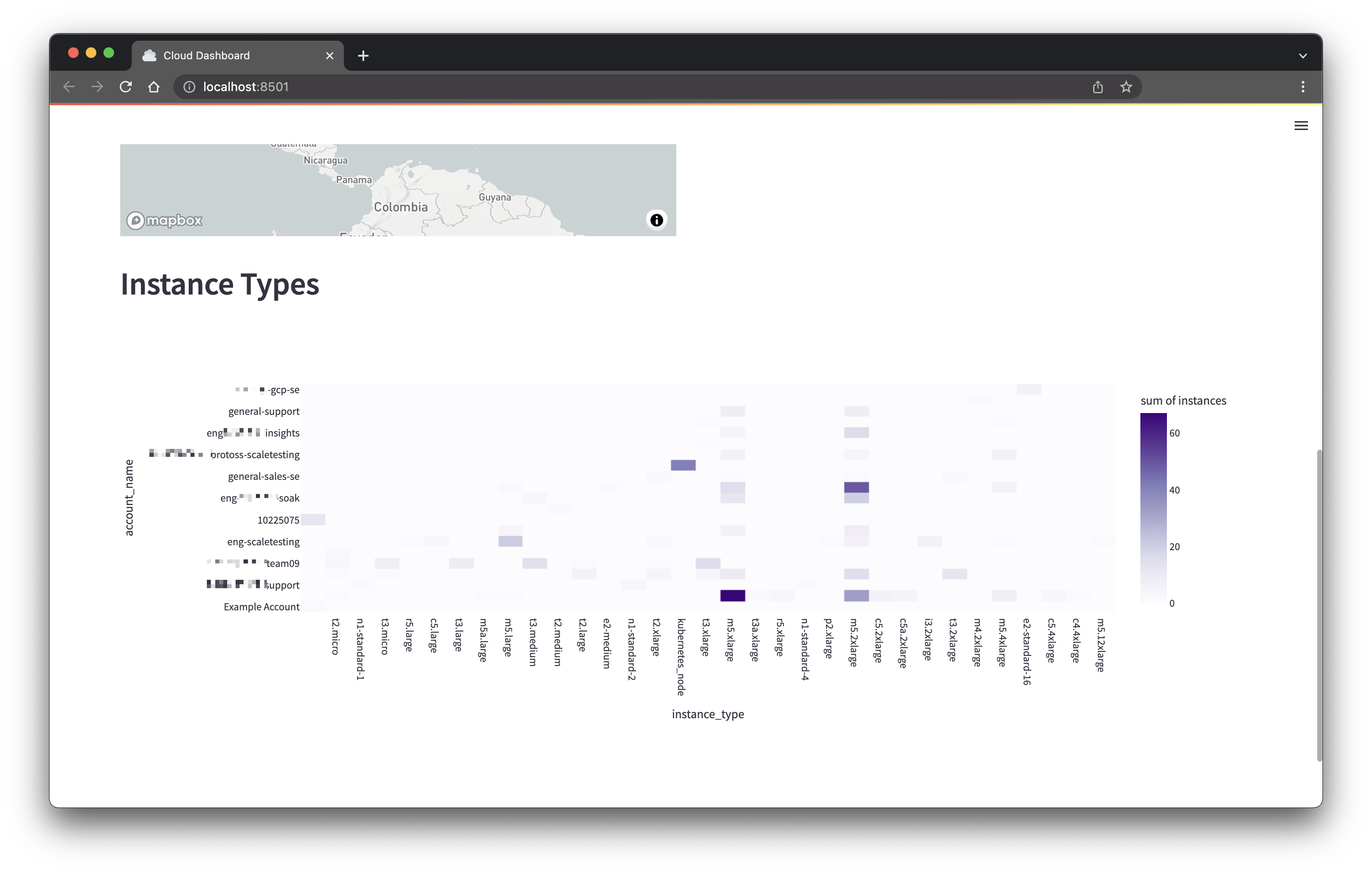
Instance Age Distribution
Finally, we will add a histogram of the instance age distribution. (We're adding this last because it can take a while to load.)
-
Add the following import at the top of
app.py:import pandas as pd -
Append the following code to the end of
app.py:resoto_search = "is(instance)"
df = resoto.dataframe(resoto_search)
df["age_days"] = (pd.Timestamp.utcnow() - df["ctime"]).dt.days
fig = px.histogram(
df,
x="age_days",
nbins=50,
title="Instance Age Distribution",
labels={"age_days": "age in days"},
color="account_name",
)
age_tab.plotly_chart(fig, use_container_width=True)Code Explanation
- We create a new
age_dayscolumn, calculated by subtracting thectimecolumn from the current time, and use it as the basis for the x-axis of the histogram. ctimeis the time when an instance was created.nbinsis the number of bins to use for the histogram. All instances within a certain age range are grouped together in a bin.
- We create a new
-
Reload the browser and you should see a histogram, with different colors representing different accounts:
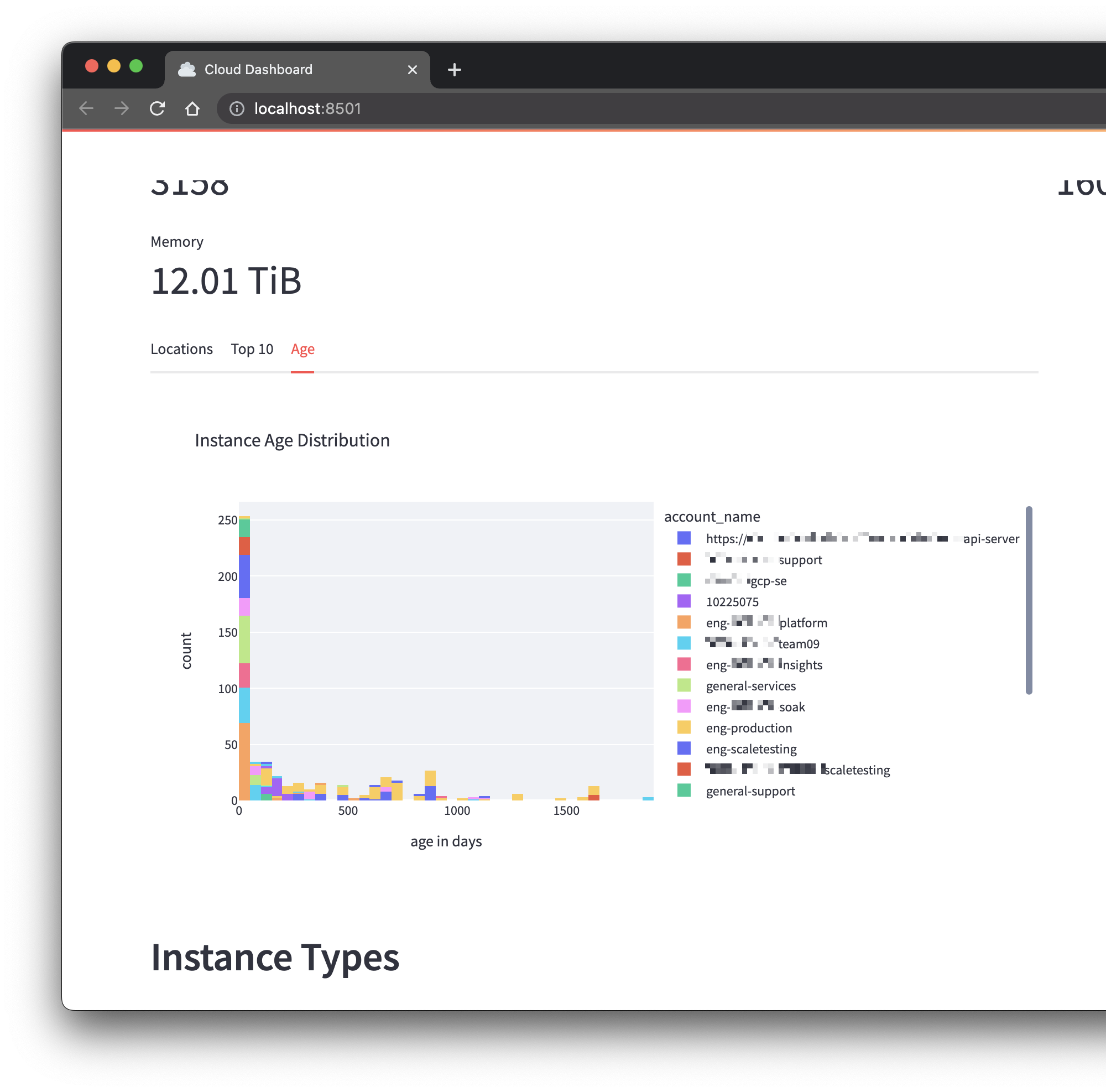
The Final Product
Complete App Code
import streamlit as st
import pydeck as pdk
import numpy as np
import pandas as pd
import plotly.express as px
from resotoclient import ResotoClient
from resotolib.utils import iec_size_format
from resotodata.cloud import regions as cloud_regions
resoto = ResotoClient(url="https://localhost:8900", psk="changeme")
# Page config
st.set_page_config(page_title="Cloud Dashboard", page_icon=":cloud:", layout="wide")
st.title("Cloud Dashboard")
# Page layout
col_instance_metrics, col_volume_metrics = st.columns(2)
col_instance_details, col_storage = st.columns(2)
map_tab, top10_tab, age_tab = col_instance_details.tabs(["Locations", "Top 10", "Age"])
# Instance metrics
resoto_search = "aggregate(sum(1) as instances_total, sum(instance_cores) as cores_total, sum(instance_memory*1024*1024*1024) as memory_total): is(instance)"
instances_info = list(resoto.search_aggregate(resoto_search))[0]
col_instance_metrics.metric("Instances", instances_info["instances_total"])
col_instance_metrics.metric("Cores", instances_info["cores_total"])
col_instance_metrics.metric("Memory", iec_size_format(instances_info["memory_total"]))
# Volume metrics
resoto_search = "aggregate(sum(1) as volumes_total, sum(volume_size*1024*1024*1024) as volumes_size): is(volume)"
volumes_info = list(resoto.search_aggregate(resoto_search))[0]
col_volume_metrics.metric("Volumes", volumes_info["volumes_total"])
col_volume_metrics.metric("Size", iec_size_format(volumes_info["volumes_size"]))
# World map of instance locations
resoto_search = "aggregate(/ancestors.cloud.reported.name as cloud, /ancestors.region.reported.name as region: sum(1) as instances_total): is(aws_ec2_instance) or is(gcp_instance)"
df = resoto.dataframe(resoto_search)
df["latitude"], df["longitude"] = 0, 0
for x, y in df.iterrows():
location = cloud_regions.get(y["cloud"], {}).get(y["region"], {})
df.at[x, "latitude"] = location.get("latitude", 0)
df.at[x, "longitude"] = location.get("longitude", 0)
midpoint = (np.average(df["latitude"]), np.average(df["longitude"]))
map_tab.pydeck_chart(
pdk.Deck(
map_style=None,
initial_view_state=pdk.ViewState(
latitude=midpoint[0], longitude=midpoint[1], zoom=2, pitch=50
),
tooltip={
"html": "<b>{instances_total}</b> instances running in {region} ({cloud})",
"style": {
"background": "grey",
"color": "white",
"font-family": '"Helvetica Neue", Arial',
"z-index": "10000",
},
},
layers=[
pdk.Layer(
"ColumnLayer",
data=df,
get_position=["longitude", "latitude"],
get_elevation="instances_total",
get_fill_color="cloud == 'aws' ? [217, 184, 255, 150] : [255, 231, 151, 150]",
elevation_scale=10000,
radius=100000,
pickable=True,
auto_highlight=True,
)
],
)
)
# Top 10 accounts and regions by on-demand cost
top10_tab.header("Top 10 accounts and regions")
resoto_search = "aggregate(/ancestors.cloud.reported.name as cloud, /ancestors.account.reported.name as account, /ancestors.region.reported.id as region: sum(/ancestors.instance_type.reported.ondemand_cost) as ondemand_cost): is(instance)"
df = (
resoto.dataframe(resoto_search)
.nlargest(n=10, columns=["ondemand_cost"])
.sort_values(by=["ondemand_cost"], ascending=False)
.reset_index(drop=True)
)
top10_tab.table(df.style.format({"ondemand_cost": "${:.2f}/h"}))
# Sunburst of storage distribution
resoto_search = "aggregate(/ancestors.cloud.reported.name as cloud, /ancestors.account.reported.name as account: sum(volume_size*1024*1024*1024) as volume_size): is(volume)"
df = resoto.dataframe(resoto_search)
df["volume_size_human"] = df["volume_size"].apply(iec_size_format)
fig = px.sunburst(
df,
path=["cloud", "account"],
values="volume_size",
hover_data=["cloud", "account", "volume_size_human"],
)
fig.update_traces(hoverinfo="label+percent entry", textinfo="label+percent entry")
col_storage.plotly_chart(fig)
# Heatmap of instance types
st.header("Instance Types")
resoto_search = "aggregate(/ancestors.cloud.reported.name as cloud, /ancestors.account.reported.name as account_name, instance_type as instance_type, instance_cores as instance_cores: sum(1) as instances): is(instance)"
df = resoto.dataframe(resoto_search).sort_values(by=["instance_cores"])
fig = px.density_heatmap(
df,
x="instance_type",
y="account_name",
z="instances",
color_continuous_scale="purples",
)
st.plotly_chart(fig, use_container_width=True)
# Age distribution of instances
resoto_search = "is(instance)"
df = resoto.dataframe(resoto_search)
df["age_days"] = (pd.Timestamp.utcnow() - df["ctime"]).dt.days
fig = px.histogram(
df,
x="age_days",
nbins=50,
title="Instance Age Distribution",
labels={"age_days": "age in days"},
color="account_name",
)
age_tab.plotly_chart(fig, use_container_width=True)
What's Next?
We've covered the basics of building a web app with Resoto and Streamlit. Currently, we are only displaying data, but in my next post we will introduce input widgets to add interactive functions to the app.
